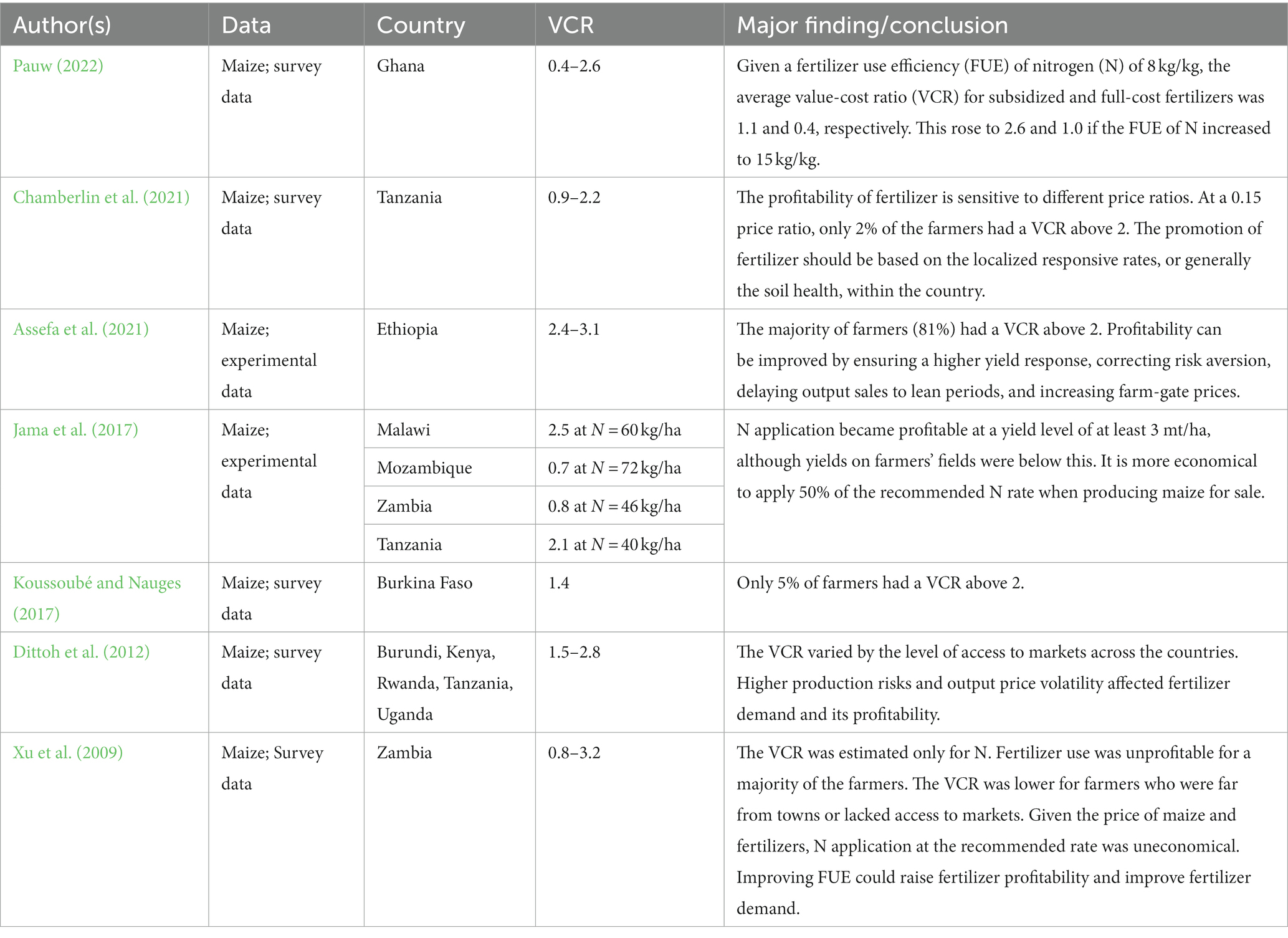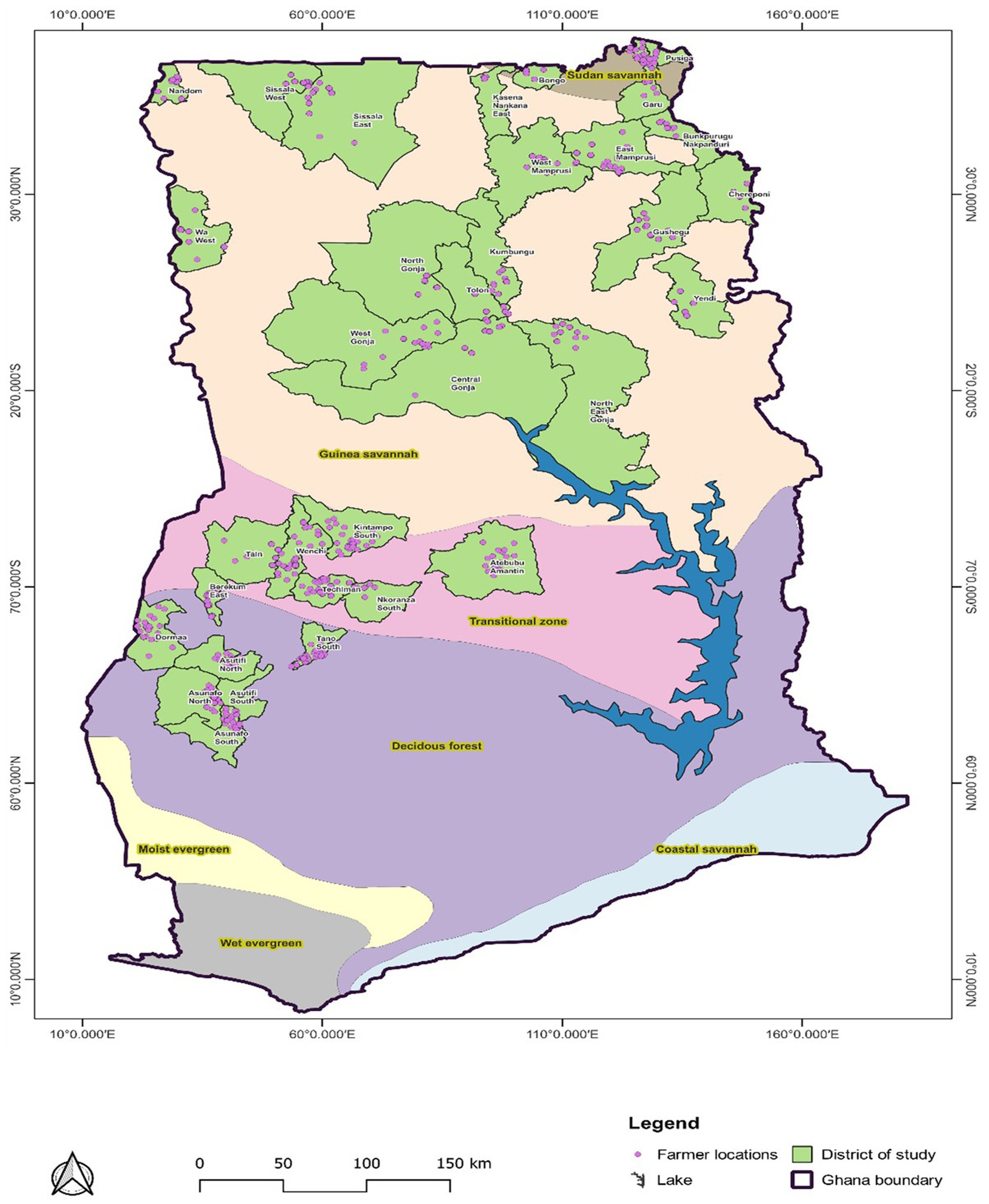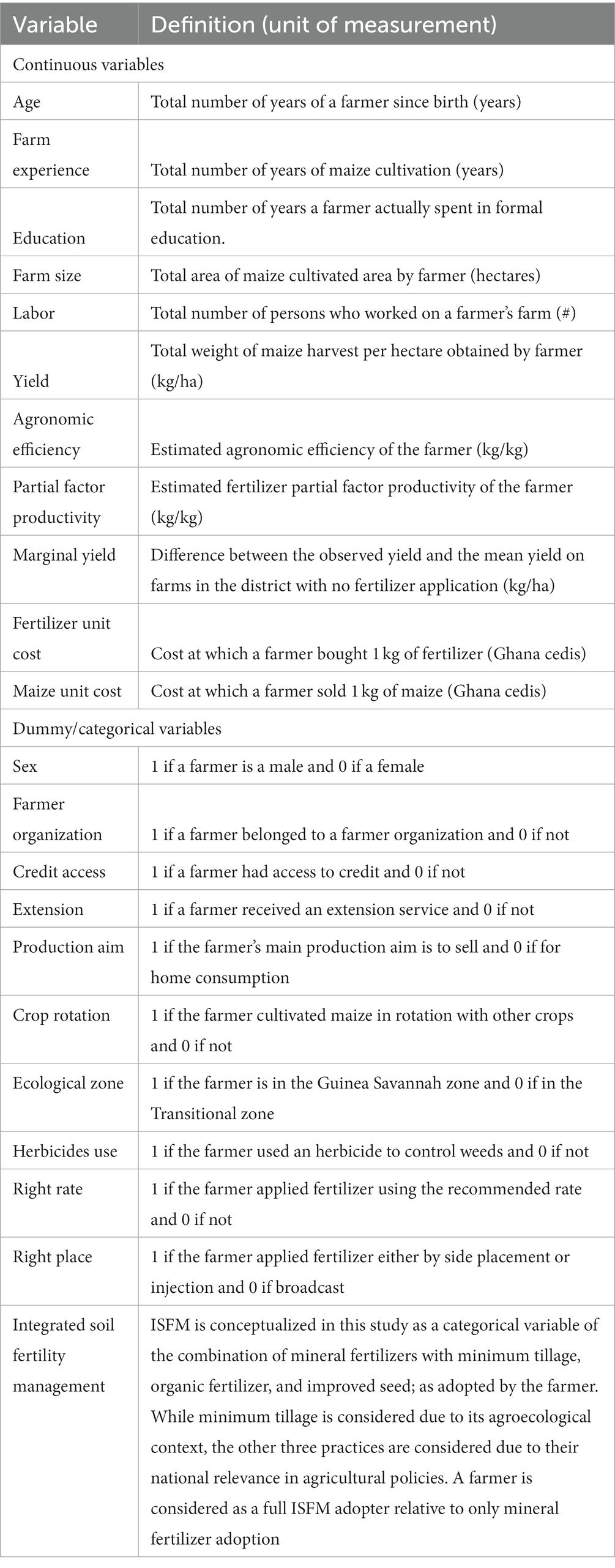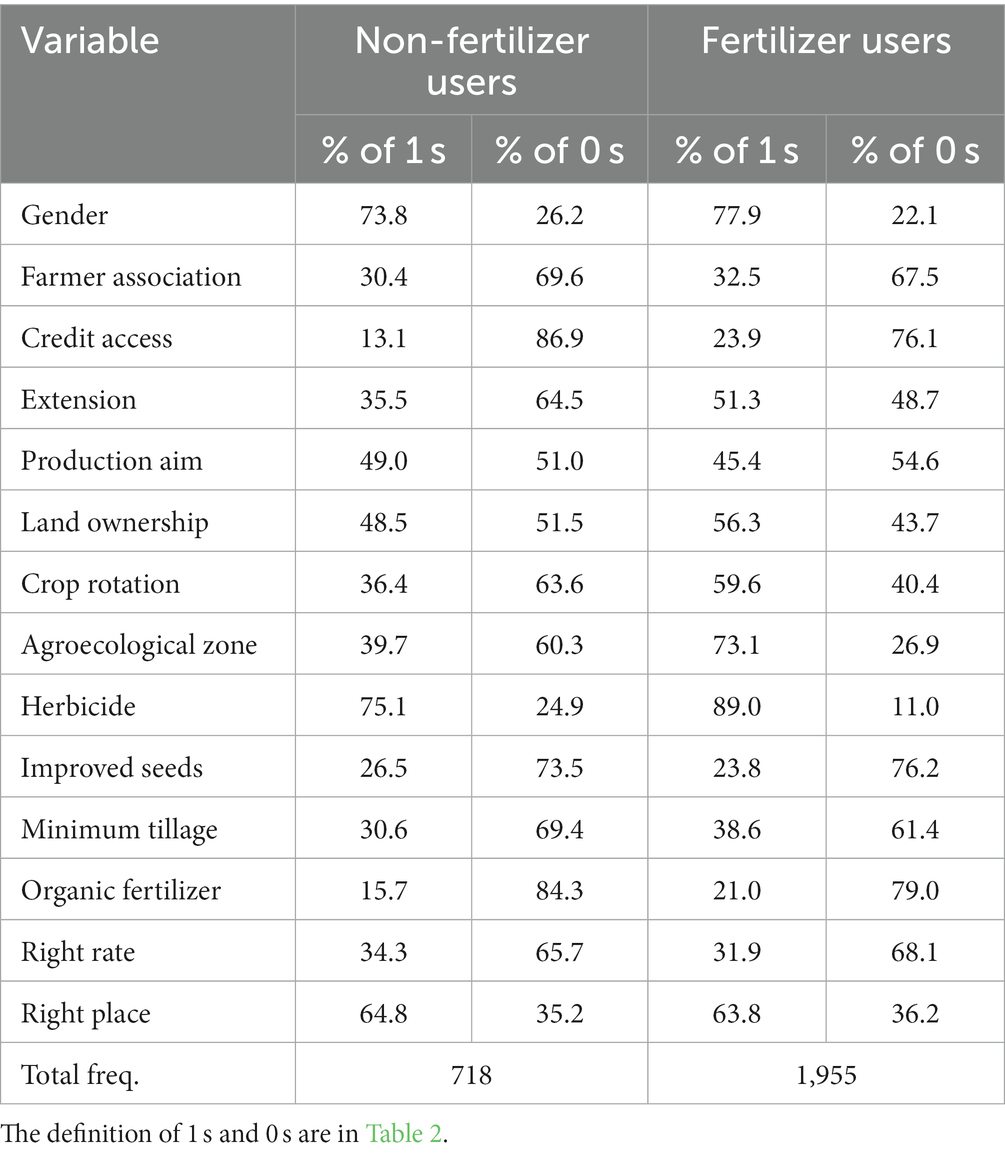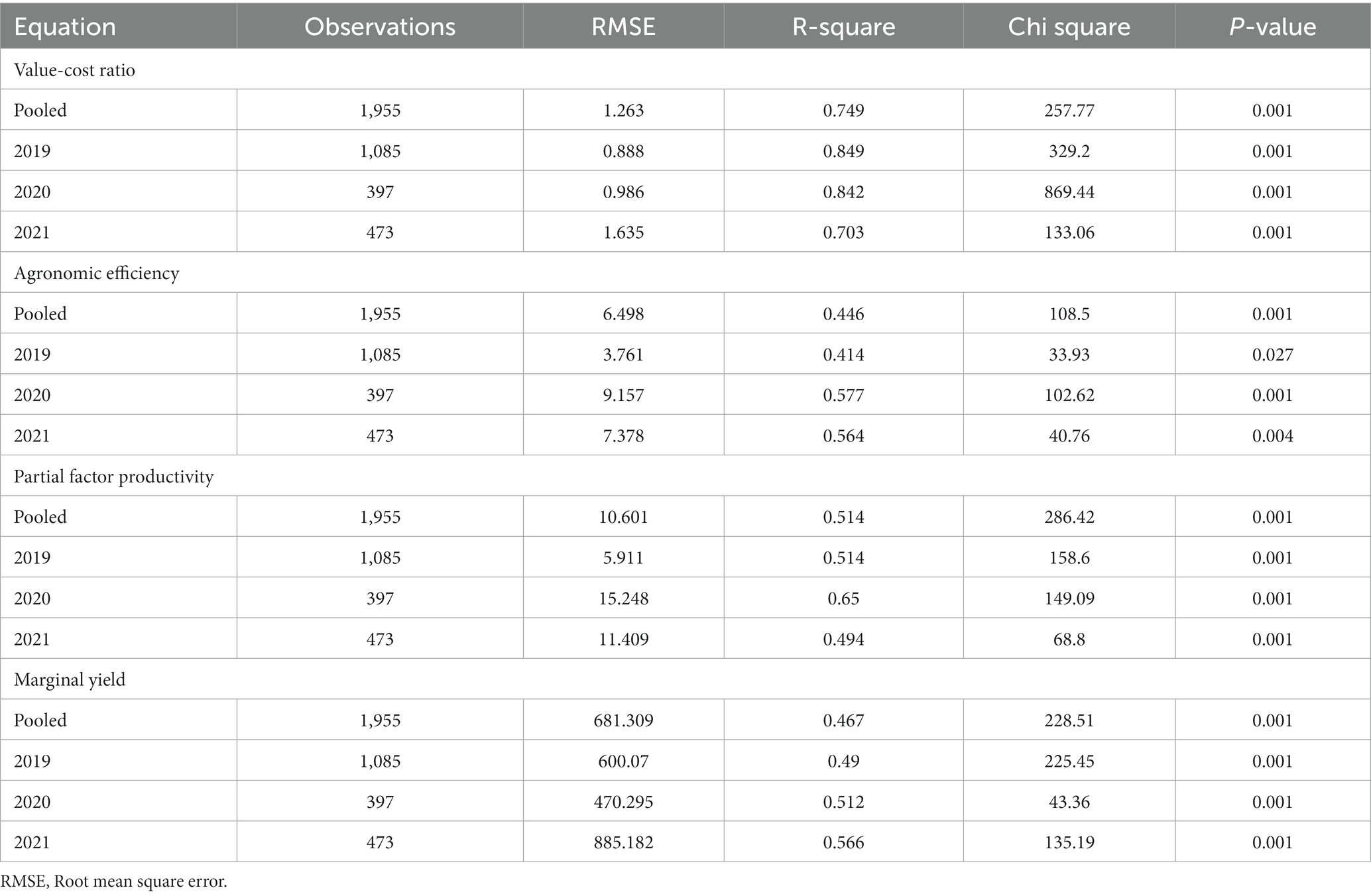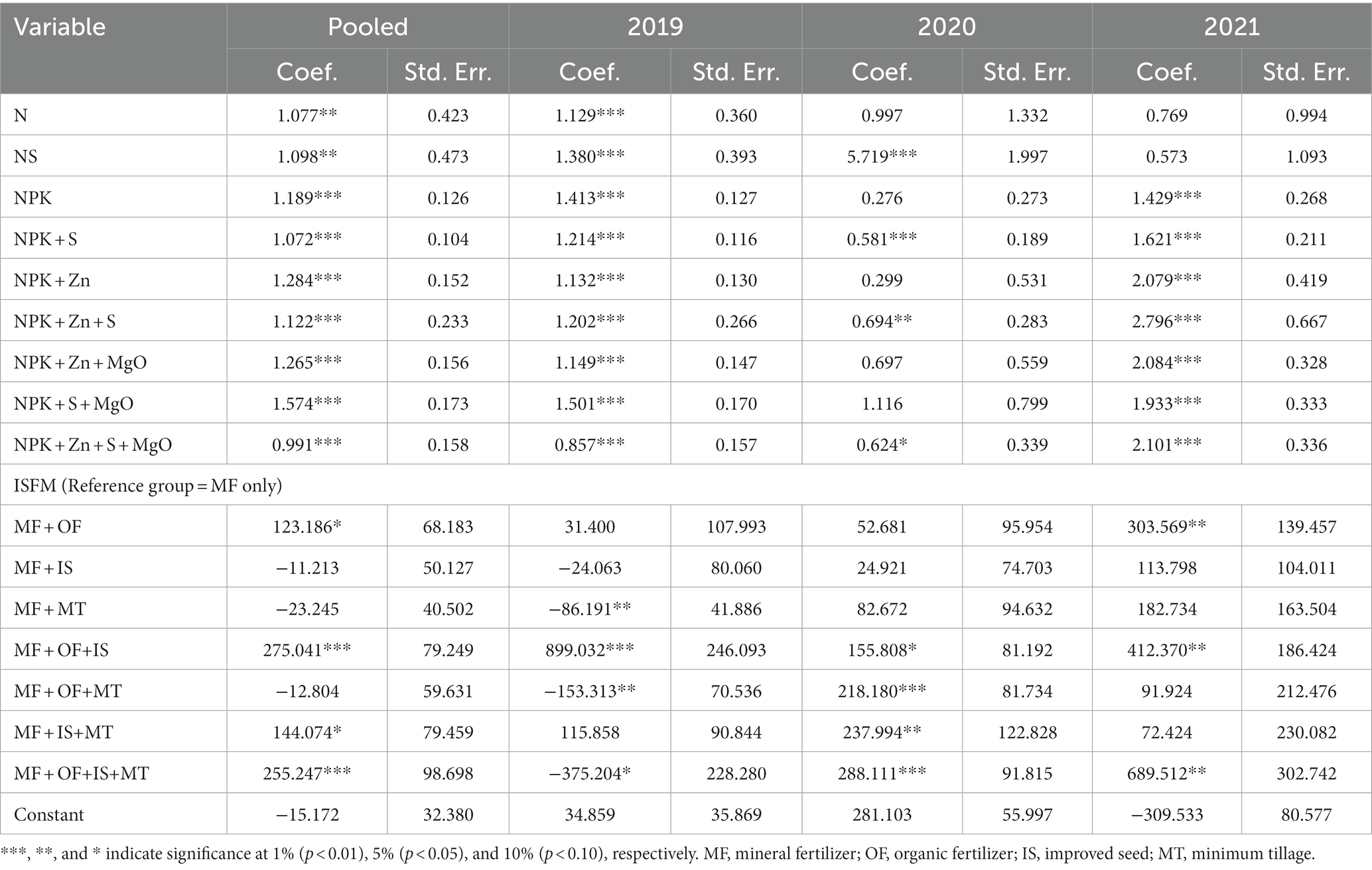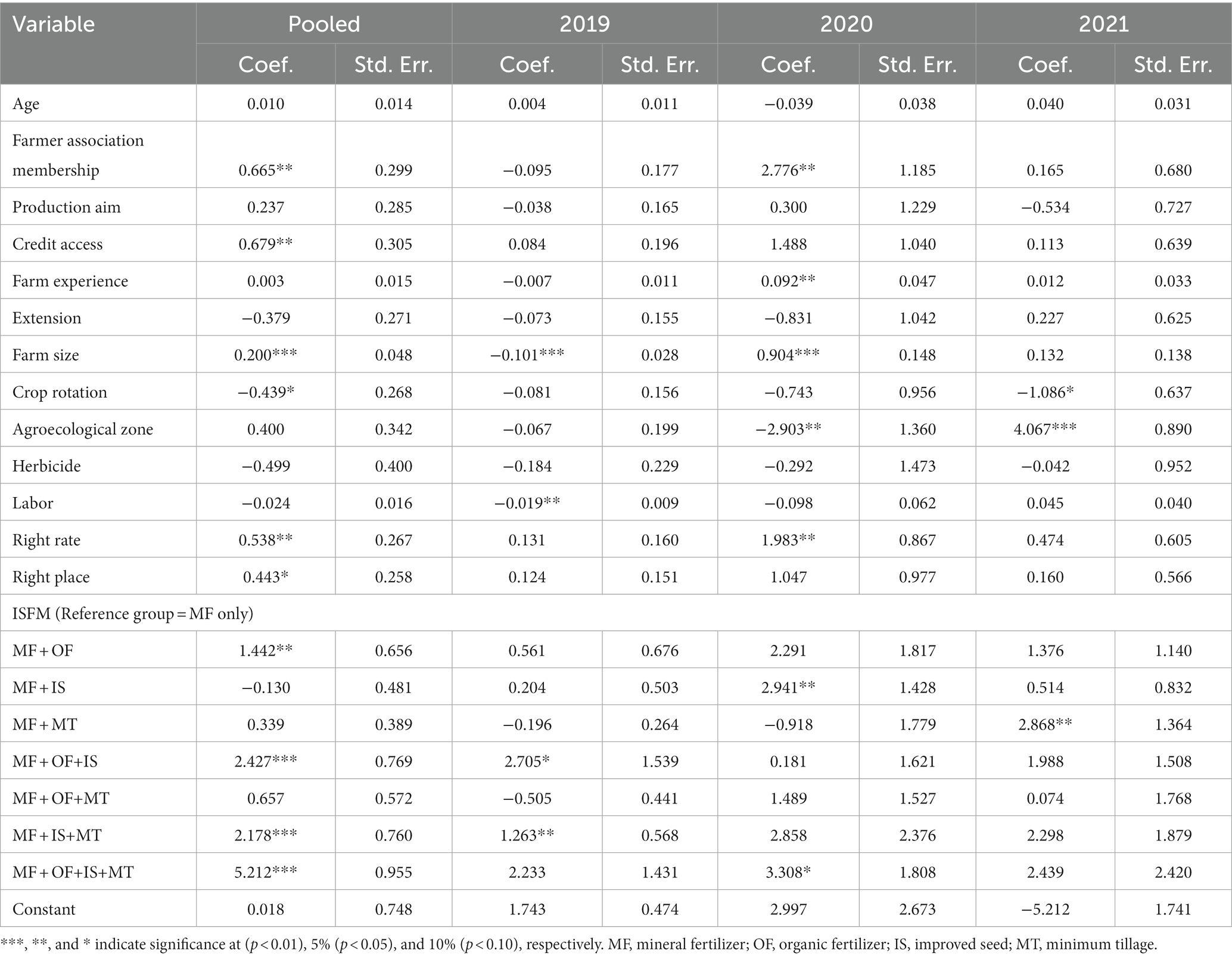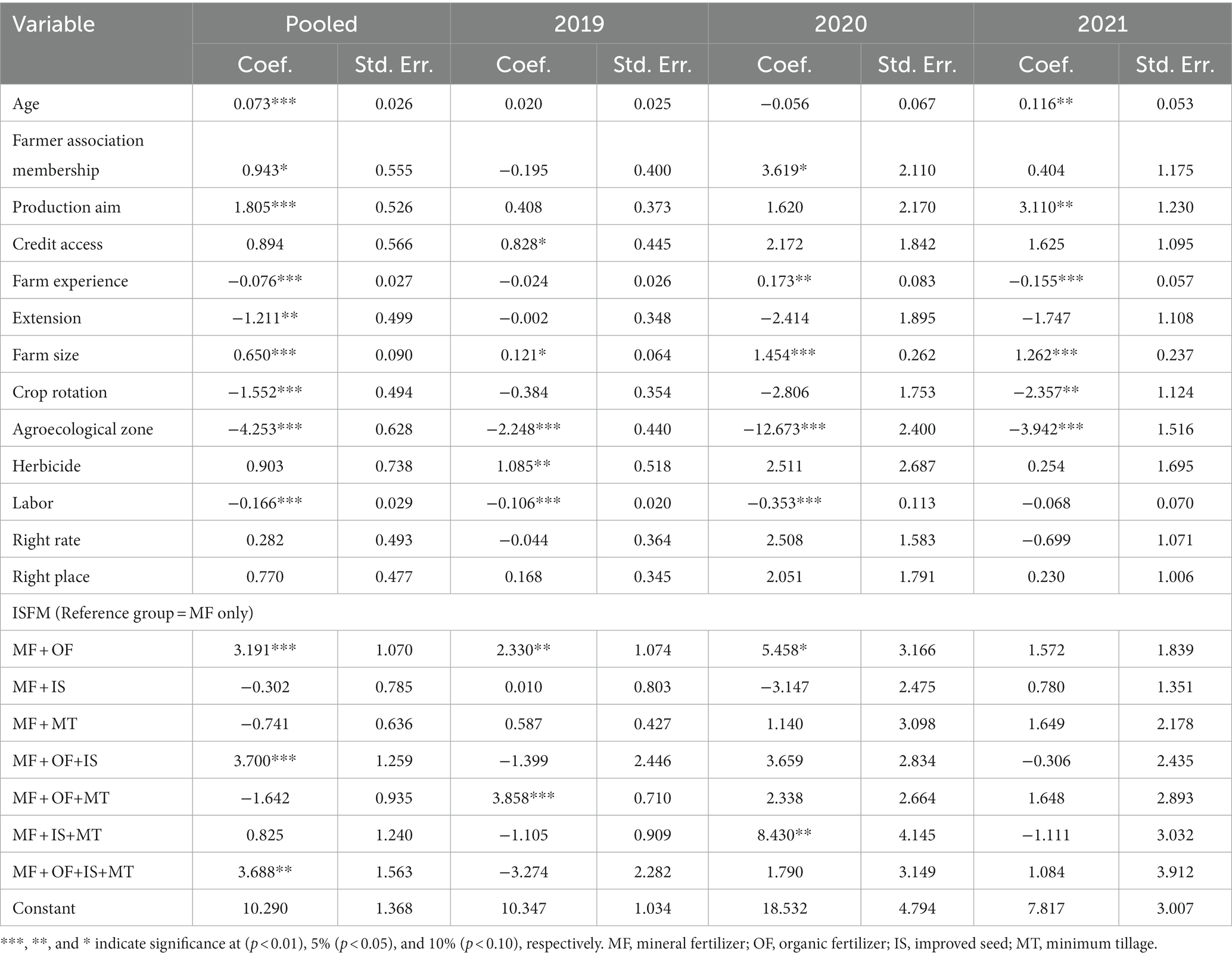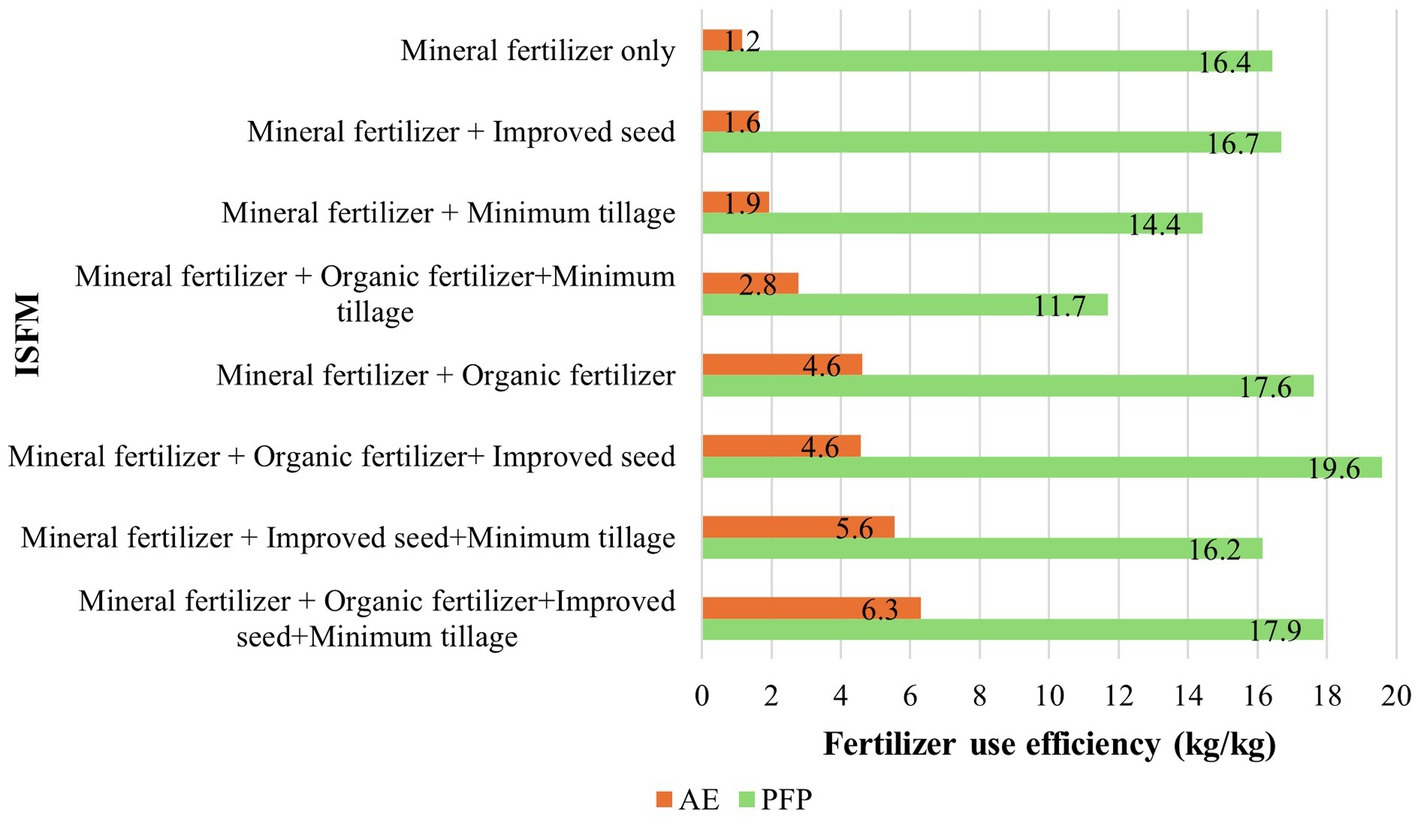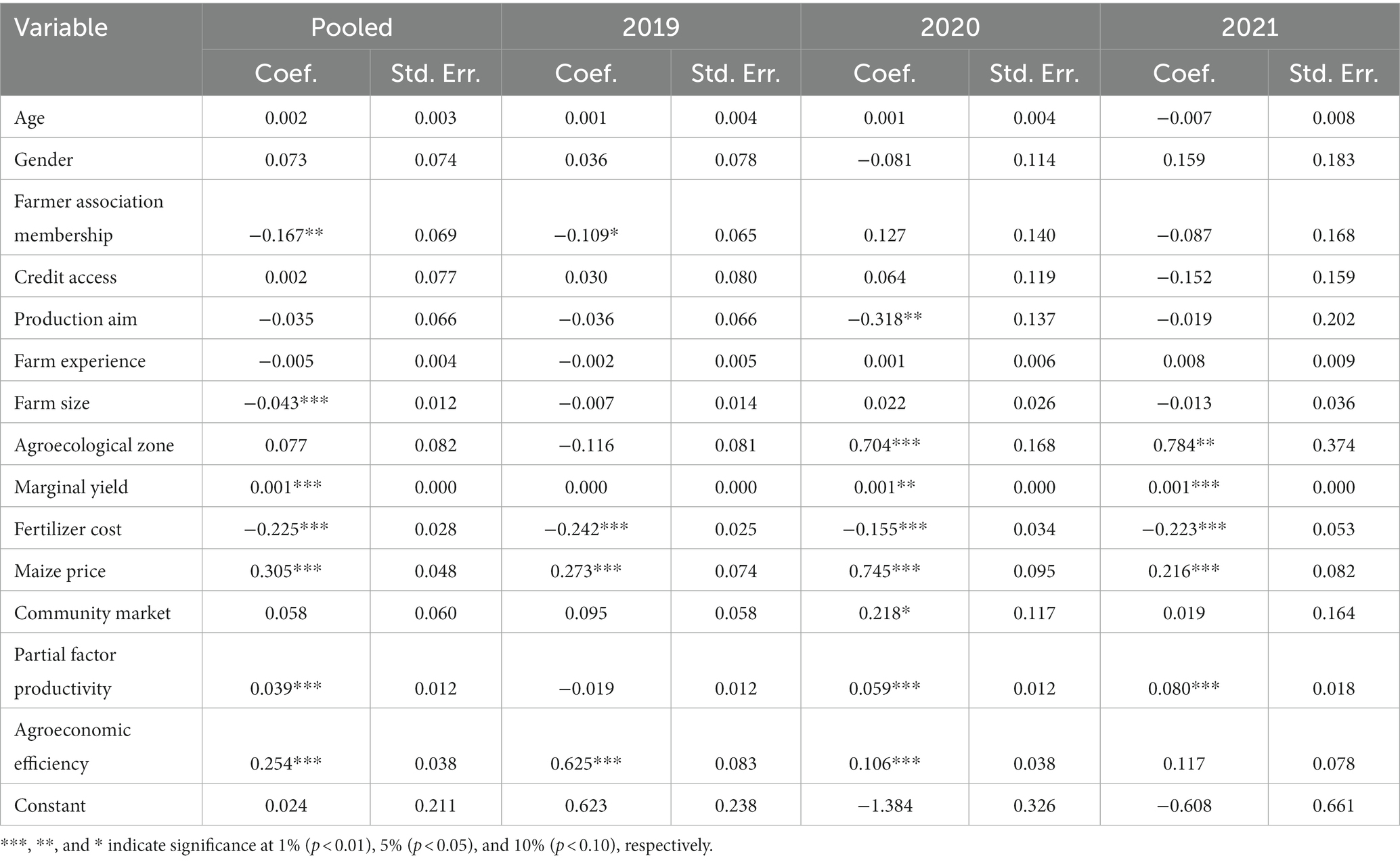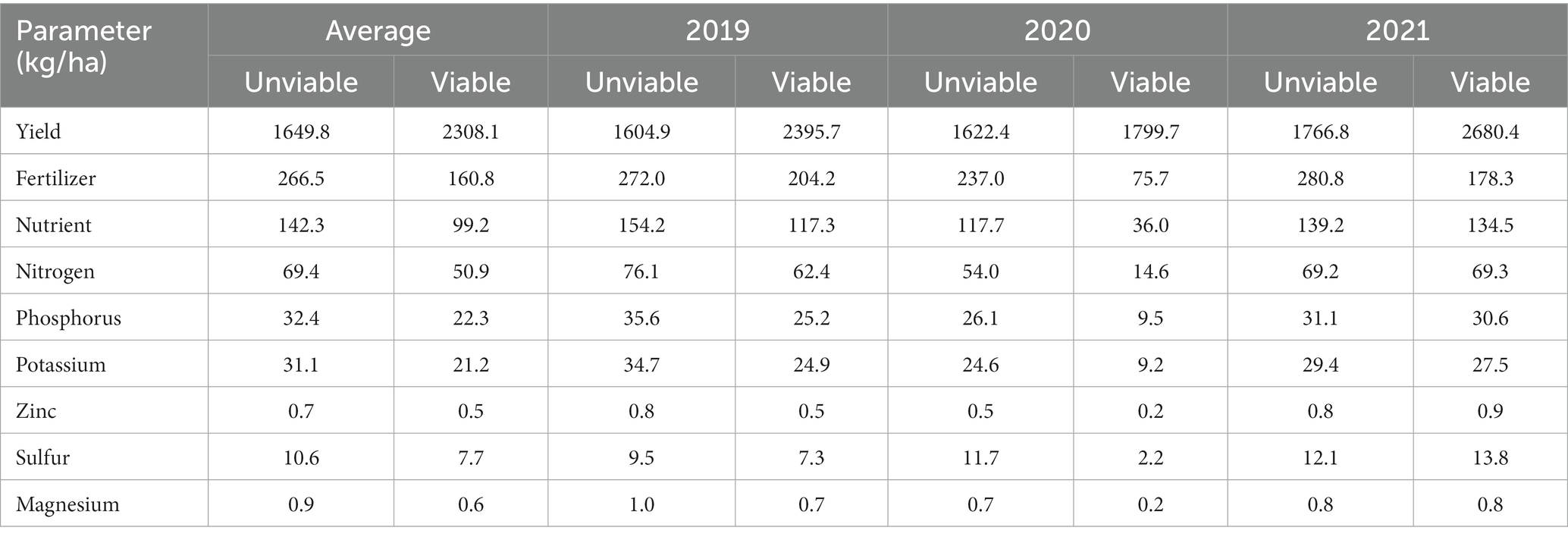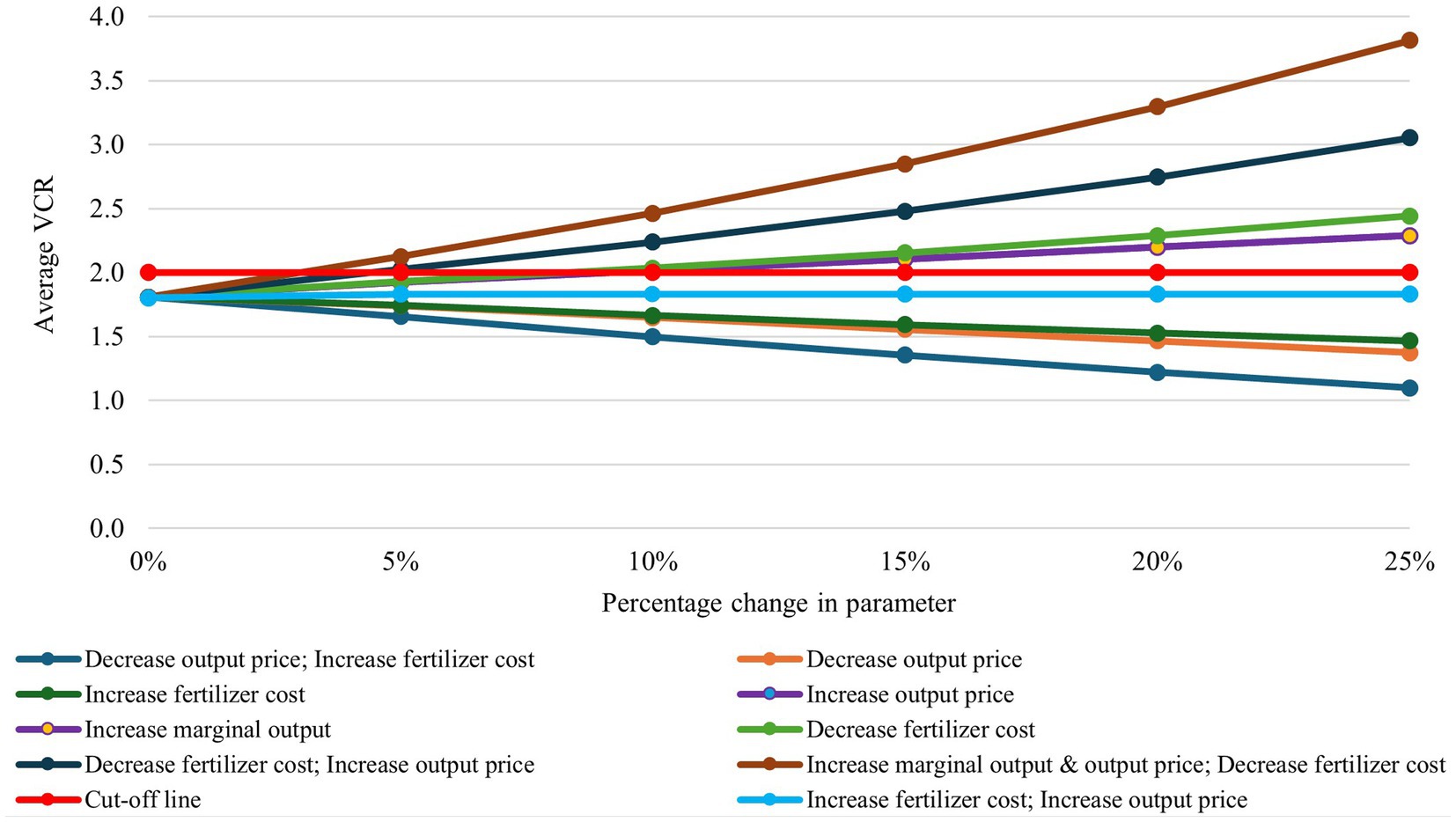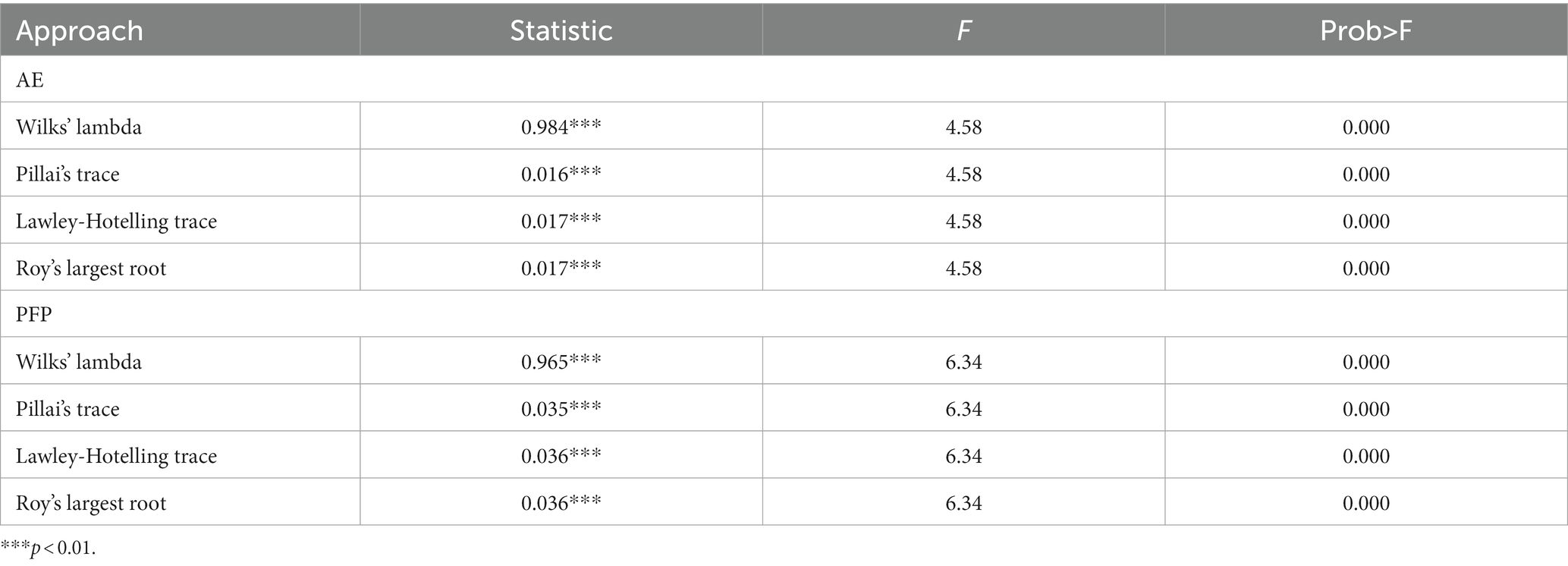- 1International Fertilizer Development Center, Accra, Ghana
- 2Department of Agribusiness, University for Development Studies, Tamale, Ghana
- 3Centre for Crop Systems Analysis, Wageningen University & Research, Wageningen, Netherlands
- 4Agricultural Innovation and Technology Transfer Center, Mohammed VI Polytechnic University, Ben Guerir, Morocco
- 5AgroBiosciences Program, College of Sustainable Agriculture and Environmental Sciences, Mohammed VI Polytechnic University (UM6P), Bengeurir, Morocco
Increasing fertilizer use is highly justified for sustainable agricultural intensification if yield response, fertilizer use efficiency (FUE), and economic viability of fertilizer application are high. Despite the increasing fertilizer application rates in Ghana, yields only marginally increased. Also, the recent fertilizer price hikes post COVID-19 revived concern for economic analysis of fertilizers. This study analyzed the FUE and economic viability of fertilizer use in maize production in Guinea/Sudan Savannah and Transitional/Deciduous zones of Ghana. Survey data from 2,673 farmers in the 2019, 2020, and 2021 production seasons were used. The average agronomic efficiency (AE), partial factor productivity (PFP), and value-cost ratio (VCR) of fertilizer use were 2.2 kg of grains per kilogram of fertilizer, 18.3 kg grains per kilogram of fertilizer, and 1.8 Ghana cedis of marginal yield per Ghana cedi spent on fertilizer, respectively. Fertilizer use was economically viable for only 28.1% of farmers with a VCR of 2 or higher, while 52.5% reached the break-even point with a VCR of at least 1. Various fertilizer formulations, including NPK plus sulfur, and adoption of integrated soil fertility management (ISFM) practices, particularly improved seeds, organic fertilizers, and minimum tillage, improved maize yield response to fertilizer and thus the FUE. These low efficiency and economic viability of fertilizer use are prevailing conditions in other sub-Saharan Africa (SSA) countries and these do not guarantee sustainable food security and improved livelihood of the farmers in the region. Ghana’s Ministry of Food and Agriculture (MoFA), together with relevant stakeholders, should provide guidance on ISFM and intensify farmer education through farmer associations to increase the adoption of ISFM. The local government should work with other relevant stakeholders to improve the market conditions within the agriculture sector, for instance, by linking farmers to city markets for favorable output prices.
1 Introduction
Maize production, trade, and consumption are vital elements in global agrifood systems and achievement of the sustainable development goals (SDGs). Maize’s contribution to a household’s calorie intake is significantly high, especially in areas such as SSA (Poole et al., 2021; Erenstein et al., 2022). It is cultivated in every region and serves as a staple food crop for almost every household and as animal feed in Ghana. The crop is primarily cultivated on small farms of less than 5 ha, mostly using traditional farming methods (Darfour and Rosentrater, 2016; MoFA, 2021). Despite the potential for higher maize yields in Ghana, several limiting factors exist, including soil degradation, pests and diseases, and limited access to input and output markets (Martey et al., 2020; Koffi et al., 2021). For instance, the low reliance on saved seeds has constraint potentials for increase yields and the low access to tractor services has resulted in untimely planting for some farmers. There is also reported low access to mineral fertilizers at communities that are far from the district capitals (Adzawla et al., 2021a). Other challenges include an overreliance on rainfed agriculture; inappropriate use of fertilizer through broadcasting and applying the fertilizers not early enough for the uptake by the crops, improved seeds, and other inputs; limited use of agricultural machinery; poor infrastructure; climate change (Adu et al., 2014; Awunyo-Vitor et al., 2016; Ntiamoah et al., 2022); soil acidity; and, until recently, a blanket fertilizer application rate. These challenges make it difficult to maintain high yields over the long term. Meanwhile, the use of improved technologies such as improved seeds and appropriate fertilizers and farm management practices such as effective weed control can result in yields of 5–8 mt/ha or even higher for the Ghanaian maize farmer (Adzawla et al., 2021b; Boullouz et al., 2022).
One of the major strategies for improving yields in Ghana is to increase the quantity of inputs, particularly fertilizers. Guided by Africa’s regional policy toward increasing farmers’ fertilizer application rates, since 2008 the government of Ghana has implemented various initiatives, including provision of fertilizer subsidies and the establishment of fertilizer distribution centers, to support fertilizer use and increase access to affordable fertilizers (Azumah and Zakaria, 2019; Andani et al., 2020; Tsiboe et al., 2021). The government has also recently begun to promote the use of fertilizer blends by farmers (MoFA, 2019). Despite these efforts, several challenges constrain fertilizer use in Ghana. These include the high cost of fertilizers, limited availability and accessibility of quality fertilizers, and a lack of knowledge and information among farmers about appropriate fertilizer use. Nevertheless, several studies have concluded that fertilizer use leads to an increase in maize yields in the country (Tahiru et al., 2015; Buah et al., 2017; Ragasa and Chapoto, 2017; Asante et al., 2019; Adzawla et al., 2021a,b; Kouame et al., 2023). For example, using data from a controlled experiment, Tahiru et al. (2015) estimated yield increases from 84 to 90% due to fertilizer application. Importantly, such yield increments will result in not only farmers’ ability to meet their household food needs, but also a significant increase in their incomes. Thus, fertilizer use contributes to poverty reduction among farming households and influences the food supply and demand system, which ultimately benefits both producers and consumers. This implies that the decision to use fertilizers goes beyond the experimentally positive yield outcomes to include the expected economic incentive or utility derived by farmers. For Morris et al. (2007), the low rate of fertilizer use in Africa is because it is less profitable. Therefore, a lasting solution would be to tackle the underlying structural challenges that undermine the incentive for farmers to use the fertilizers. For instance, a major disincentive to fertilizer use in Ghana is the observed low crop response to fertilizers (Jayne et al., 2015). For a Green Revolution to be successful in Ghana, crop response to fertilizers must be improved and marketing challenges for both fertilizers and crop outputs must be addressed.
Fertilizer use efficiency (FUE), a measurement of crop response to fertilizers, is a critical issue for Ghana’s agriculture sector. Inefficient fertilizer use can lead to increased production costs, lower crop yields, and negative environmental impacts, such as soil degradation and water pollution (Dimkpa et al., 2023; Penuelas et al., 2023). Although national apparent fertilizer consumption has been high at 423,604 mt in 2019 and 459,518 mt in 2022,1 yields and FUE have been low. Ragasa and Chapoto (2017) estimated that an additional 1 kg of nitrogen applied to maize results in an additional 22–26 kg of grains in Ghana, while Essel et al. (2020) estimated an agronomic efficiency of nitrogen of 2.5 kg/kg at an N rate of 120 and 14.9 kg/kg at an N rate of 30 kg/ha. The low FUE in Ghana has been attributed to several factors, including suboptimal application rates and methods (Tetteh et al., 2017; Martey et al., 2019). For instance, farmers may apply too little or too much fertilizer or apply it at the wrong time, which can reduce the effectiveness of the fertilizer and lead to nutrient losses. Moreover, low-quality fertilizers can have a low nutrient content, inconsistent composition, or a high level of impurities, which can reduce their effectiveness and contribute to the low FUE.
In addition to the FUE, the economic aspect of input use must also be considered, as this determines the profitability of fertilizer use (Morris et al., 2007). Fertilizer use can be profitable for maize farmers in Ghana if applied correctly and in the appropriate quantity (Ragasa et al., 2014; Essel et al., 2020). Essel et al. (2020) estimated that the economically optimal level of nitrogen application in the Semi-Deciduous Forest zone of Ghana is 61 kg/ha, beyond which fertilizer application becomes uneconomical. The value-cost ratio (VCR) of ammonium sulfate for maize production has decreased from 6.8 in the early 1980s to 2.2 in the early 2000s (Morris et al., 2007) due to changes in the price of fertilizer and maize. Jayne et al. (2015) argued that despite the absence of detailed information on the VCR among Ghanaian farmers, fertilizer use is unprofitable for many of them. Various studies across Africa have estimated the economic viability of fertilizer use (Table 1). Nonetheless, the information on Ghana is scanty, with no thorough analysis focusing on the factors through which the economic incentive for fertilizer use can be improved in the country. The lack of understanding of the economic viability of fertilizer use can have negative implications on the sustainable transformation of the agriculture sector and the sustenance of farmers’ livelihoods. In addition to the already complex challenges affecting the profitability of fertilizers, the COVID-19 pandemic has also had a negative effect (Nhemachena and Murwisi, 2020; Onyeaka et al., 2022; Mutegi et al., 2024), especially on international fertilizer prices (FAO, 2022) which were transmitted into local pricing. The resultant limited access to input markets and income losses due to the pandemic have had a significant influence on the farm investment decisions of farmers (Martey et al., 2022). With the rising prices, the government of Ghana has continued to reduce its subsidy rates on fertilizers, eventually discontinuing the subsidy in 2023, causing farmers to bear the brunt of the price hike. Thus, even when the international fertilizer prices declined as the pandemic subsided, Ghanaian farmers paid more than in previous years. Considering the complex fertilizer supply dynamics, farmers must be able to obtain higher marginal outputs and favorable output prices to maintain the demand for fertilizers. Therefore, the objectives of this study are to analyze the: (1) FUE, proxied by agronomic efficiency (AE) and partial factor productivity (PFP), and their determinants, and (2) economic viability of fertilizer use and its determinants, and (3) incentives to improve FUE and economic viability in the Savannah and Transitional zones of Ghana.
2 Methodology
2.1 Study location
Respondents in the study were farmers selected from the Guinea/Sudan Savannah and Transitional/Deciduous zones of Ghana, specifically from eight of Ghana’s 16 administrative regions (Figure 1). The Guinea and Sudan Savannah zones together form the largest agroecological zone in terms of Ghana’s landmass. The major soil types in the Guinea Savannah zone are ferric acrisols, lixisols, nitisols, and plinthosols (Bationo et al., 2018). The soils are shallow, with an organic carbon content of 0.5–1%, total nitrogen content of 0.05–0.12%, available phosphorus content of 0.2–3.6 mg/kg, and available potassium content of 46.2–55.3 mg/kg. Iron pan and water erosion in particular are found in the zone and the soil pH ranges 6.2–6.7 (Bationo et al., 2018). There is high nutrient depletion in the zone, especially due to annual burning and removal of crop residues, which hinders the buildup of organic matter in the soils. While rainfall in the zone is highly variable, water evaporation is rapid due to the high atmospheric temperature. The major soils of the Transitional zone are the dystric nitisols, chromic lixisols, and ferric acrisols (Bationo et al., 2018). The organic matter content is 0.6–1%, with a soil pH of 5.1–6.4, total nitrogen and available phosphorus and potassium of 0.04–0.16%, 0.3–4.7 mg/kg, and 58.3–72.5 mg/kg, respectively (Bationo et al., 2018). Maize is an important crop grown in these agroecological zones, although a gap between the actual and potential yields remains. The Fertilizer Research and Responsible Implementation (FERARI) program,2 managed by the International Fertilizer Development Center (IFDC), is currently being implemented in these zones. The program aims to increase sustainable intensification through appropriate and innovative fertilizer recommendations for maize, rice, and soybean production to achieve higher yields, improved food security, and reduced poverty among the farmers. This study complements FERARI’s efforts to solve fertilizer use efficiency challenges and advance practical solutions for improving returns on farmers’ investments in fertilizers for maize production in the zones.
2.2 Data type, sampling, and data collection
The study relied on primary data collected on maize production in 2019, 2020, and 2021. Multistage sampling procedures involving purposive, simple random, and systematic sampling were used. The eight of the 16 regions were purposely selected due to the implementation of FERARI activities in these regions. In 2019, three districts were randomly selected from the list of districts with high receipt of subsidized fertilizers under the government of Ghana’s Planting for Food and Jobs program. In 2020, three districts with high maize production potential were selected from each region using simple random sampling. In 2021, two districts from the selected 2020 districts were randomly selected. In all, data from 33 districts were used for analysis. Secondly, in each selected district, four communities were sampled using a simple random sampling procedure and 15–20 farmers were selected in each of the selected communities through systematic sampling procedures.
The sample of farmers for each period was based on the Yamen’s sample size calculator, given as (Yamane, 1967) (Equation 1):
Where n is the sample size, N is the population of farm households which is given as 902,186 farm households from the studied regions (MoFA, 2021), and e is the margin of error which is assumed at 5%. Thus the sample is determined in Equation (2) as:
Thus, a minimum sample of 400 is required for this study. However, considering that farmers were the sampling unit other than farm households, and to accommodate for non-responsiveness of some sampled farmers, the sample size for each year was adjusted upwards based on the primary objective of the survey in each year. Overall, in the final stage of the sampling, 1,450, 745, and 886 farmers were sampled in 2019, 2020, and 2021, respectively. Of the interviewed farmers, 2,673 (1,363 in 2019, 521 in 2020, and 789 in 2021) cultivated maize, and these farmers were retained for analysis in this study.
The data for the three time periods were collected using questionnaires that were designed and uploaded onto a mobile data collection platform. The questionnaires were pretested for clarity, consistency, and reliability, and the results of the pretest were used to finalize the data collection tools. Research assistants with a good understanding of the agriculture sector, experience in mobile data collection, and an understanding of the local setting, including the local dialects, were trained and engaged for data collection.
2.3 Data analysis
The data were analyzed through descriptive statistics estimation of VCR, AE, and PFP and three-stage least square regression of the effect of AE and PFP on the economic viability of fertilizer use in maize production. Several methods can be used to estimate FUE (Fixen et al., 2014), but based on the available data, in this study two variables were used: AE and PFP. The PFP was estimated as in Equation (3) (Fixen et al., 2014):
where Y represents the yield from the fertilized maize farm (reported yield of farmers who used fertilizer) and F is the quantity of fertilizer nutrient applied.
The AE was estimated in Equation (4) as the unit increase in the maize yield from a unit increase in the fertilizer nutrient applied (Fixen et al., 2014):
where is the yield when no nutrient is applied, in this case, the average yield of farmers in a particular district who did not apply fertilizer. Thus, the control yield ( for Y was proxied by the average yield on farms of non-fertilizer users who are in the immediate environment of the fertilizer users. The PFP and AE estimates provide an understanding of how a maize production system responds to fertilizer application; thus, higher values of these estimates are desirable, as they indicate that maize yields are significantly higher relative to lower fertilizer application rates.
In the absence of information on the full cost of production, the profitability of fertilizer use by farmers was estimated using the VCR approach. The VCR is obtained by dividing the value of the marginal physical product (the product of the marginal yield response to nutrient and the price of 1 kg of maize) by the price of fertilizer (Morris et al., 2007; Ragasa and Chapoto, 2017) as in Equation (5):
where and are the unit price of maize and fertilizer, respectively, and is the total kilograms of fertilizer applied by a farmer. The price of maize is the price at which individual farmers sold their maize. For farmers with no reported sales or no information on the selling price of their output, the average price of farmers who made sales was assumed. This is unlike in previous studies where regional prices, which fail to account for the price difference over time, are used instead of the selling price of the farmers. The unit price of fertilizer is the reported purchase price of the fertilizer used by each farmer. From the data, the average and were 1.5 Ghana cedis per kilogram of maize and 3.5 Ghana cedis per kilogram of fertilizer, respectively. Further, the farmers were classified into two groups: economically viable if the average VCR was at least 2 and economically unviable if the average VCR was less than 2, except in risky environment where a VCR of at least 3 or 4 may be a considered minimum (Morris et al., 2007). The benchmark of 2 helps to account for unmeasured costs associated with fertilizer use and the risks and uncertainties in crop farming and to approximate the rate at which fertilizer application is profitable (Sheahan et al., 2013). Although other authors (e.g., Dittoh et al., 2012) argue that a higher benchmark (VCR of 3 or 4) can be used under extreme production environments such as drought or an intervention, say subsidy program, there are no such exceptional production risks that was considered in this study. In addition, farmers were classified as break-even if the estimated VCR of the farmer was at least 1 (the point at which a risk-neutral farmer can increase farm revenue from fertilizer use). Beyond the VCR estimates is an understanding of the rate of fertilizer use, either underutilization or overutilization. The resource use efficiency (RUE) of an input such as fertilizer requires that the marginal value product (MVP) from fertilizer use equals its marginal factor cost (MFC) as (Miah et al., 2006; Awunyo-Vitor et al., 2016) in Equation (6):
where , is the yield of farmer i, is the quantity of fertilizer applied, and is the estimated coefficient of . The rule of thumb is that a farmer overutilized fertilizer if the estimated RUE is more than 1, underutilized fertilizer if the estimated RUE is less than 1, and efficiently used fertilizer if the RUE is equal to 1.
Having estimated the VCR, it is necessary to estimate the significance of relevant factors, such as AE, PFP, and marginal yield on the VCR level of the farmers. Given a VCR structural equation (Equation 10), the set of explanatory variables contains endogenous variables that correlate with the error term of the structural equation. The inclusion of PFP, AE and marginal yield as right-hand variables are themselves not only explained by other variables but also are seemingly unrelated. Therefore, any estimation method that threats the VCR equation as linearly related will result in biased estimates. Appropriately, the three-stage least square regression best fits to estimate such system of equations to simultaneously estimate the functions (Equations 10–13) of the endogenous factors to correct the correlation in the error terms of these functions as well as the structural VCR equation that corrects for endogeneity. The basic assumptions of the 3sls are that there is simultaneity in the model, the error terms are serially independent but correlated between equations and that the equations are correctly specified. A Bresch-Pagan LM test result of 1720.84 (p = 0.001) suggest that there is presence of overall system heterogeneity while the Harvey LM test of 1.26 (p = 0.2623) confirmed no autocorrelation as regards the serial independence assumption. Mathematically, this is given in Equation (8) as (Zellner and Theil, 1962):
where is a column vector of observations on one of the jointly dependent variable, in this case, VCR of the farmers, is a vector matrix of the explanatory dependent variables, is a vector matrix of independent variables and is a column vector of the error terms while and are coefficient estimates as in Equation (8) Zellner and Theil (1962):
Or simply, Equation 8 can be written as in Equation (9) as:
Practically, this involves three stages. In the first, the reduced forms of all the equations are estimated to obtain the estimated values of all the endogenous variables. In the second stage, the estimated values are replaced with the endogenous variables that appear on the right-hand side of the equations and the structural equations are re-estimated using least square methods. In the final stage, the variance and covariance of all the error terms are computed and seemingly unrelated regressions applied to simultaneously estimate the parameters of each equation. Therefore, the application of 3sls helps to obtain consistent and efficient estimates than it would be from single equation methods or from a two-stage least square. Due to the high number of exogenous variables hypothesized for the study, an ordinary least square was estimated to obtain the variance inflation factors which showed an average VIF of 1.5. Given this, the system of equations estimated are (Equations 10–13), with the definition and units of measurement of each variable provided in Table 2 as follows:
3 Results
3.1 Descriptive statistics of farmers
The descriptive statistics of the farmers are shown in Table 3. On average, 73.1% of the farmers used fertilizers for maize production, particularly fertilizers subsidized under Planting for Food and Jobs program. More farmers (79.6%) in the 2019 production season used fertilizers than in the 2020 (76.2%) and 2021 (59.9%) production seasons. On average, farmers were about 45 years old, with fertilizer users being significantly younger than non-users. Formal education was very low among the farmers, as a farmer typically spent only about 5 years in formal education. Farmers had an average of 18.5 years of experience in maize production; this was lower for fertilizer users than non-users. Most farmers cultivated no more than 2.0 ha of land. Although the difference was low, fertilizer users cultivated more land area (2.1 ha) than the non-fertilizer users (1.8 ha). Approximately eight individuals assisted the farmers at least once during a farm activity. Farmers’ maize yield was low at an average of 1,511.7 kg/ha: 1,599.4 kg/ha for fertilizers users and 1,273.0 kg/ha for non-users.
Table 4 also shows the percentage distribution on the categorical attributes of the farmers. More male farmers used fertilizer than female farmers, supporting the popular view that female farmers are more constrained in accessing productive resources than male farmers. Only about 30% of the farmers belonged to a farmer association, notwithstanding its importance in providing assistance in terms of access to production inputs, performance of on-farm activities, and marketing of agricultural produce. Access to credit and extension services was higher for fertilizer users than non-users. The generally low access to extension services is worrisome, as farmers require technical support from extension officers. An almost equal proportion of farmers cultivated maize both for home consumption and to sell. The higher percentage of farmers cultivating maize primarily to sell is an encouraging result, suggesting that maize production is gradually being done as a business. About half of the farmers owned the land they cultivated. Land ownership is an important factor influencing investment in land management and reducing the impact of land tenure disputes on maize production. Crop rotation was practiced slightly more by fertilizer users (60%) than non-users (50%). This is interesting, as the gains from crop rotation can complement the positive role of mineral fertilizers in maize production. Most of the farmers (60%) were from the Guinea Savannah zone and the rest were located in the Transitional zone (40%).
The use of herbicides for weed control was significantly high, with about nine in every 10 farmers applying them. This was slightly higher for fertilizer users than non-users. The use of organic fertilizers and improved seeds was low. About 40% of the farmers also did not plow their lands before planting maize. In terms of mineral fertilizer use, about 30% of farmers indicated they used the right quantity for production and 60% indicated applying fertilizer by either side placement (placing the fertilizer on the soil surface near the base of the plant) or injection (placing the fertilizer in a hole a few centimeters deep near the base of the plant).
3.2 Maize yield, fertilizer application rate and use efficiency, and profitability
Maize yield increased marginally from 2019 to 2021 (Table 5). Fertilizer use for the 3 years averaged 166.4 kg/ha, with a nutrient application rate of 91.5 kg/ha. Overall, the nutrient application rate among the farmers was lower than the generally recommended rate. On average, farmers who applied fertilizers had 289–436 kg/ha higher yields than those who did not apply fertilizer. The highest fertilizer application rate in 2019 did not result in a higher average yield, considering the marginal yield appreciation in 2020 and 2021. The FUE among the farmers was low, with an average PFP and AE of 18.3 and 2.2 kg/kg, respectively, with the highest in 2020 and lowest in 2019.
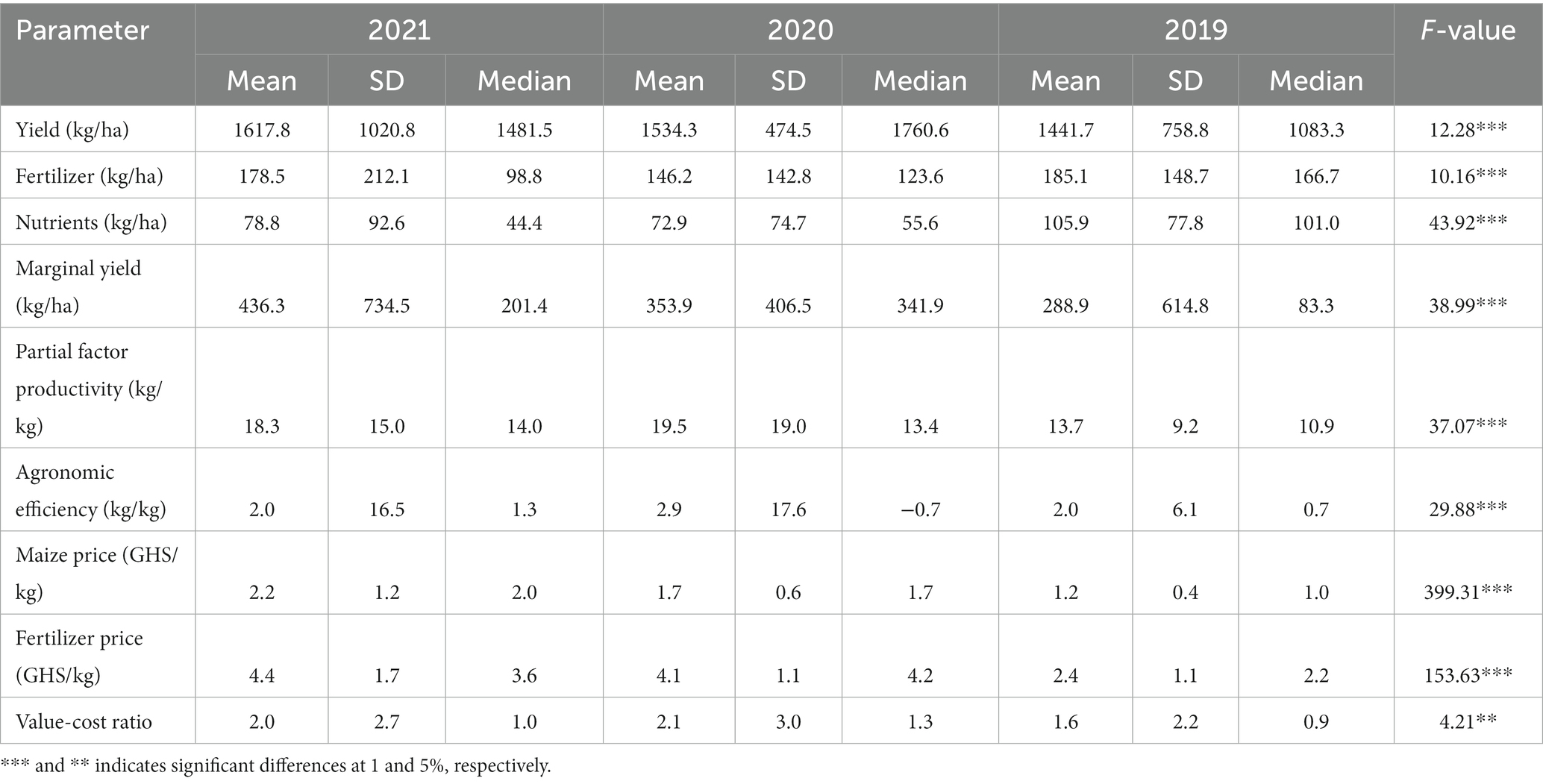
Table 5. Descriptive statistics of maize yield and fertilizer application, use efficiency, and profitability.
The price of 1 kg of maize grain increased by 0.50 Ghana cedis in each period, averaging 1.2 Ghana cedis per kilogram in 2019 and 2.2 Ghana cedis per kilogram in 2021. The price per kilogram of fertilizer averaged 2.4 Ghana cedis in 2019 and 4.4 Ghana cedis in 2021. Thus, the price per kilogram of fertilizer was higher than the price per kilogram of maize grain. The significant rise in fertilizer prices, especially in 2020 as compared to 2019, was due to two major factors. The first was the pandemic-induced low global fertilizer supply that resulted in international price hikes, and the second was the decline in the local fertilizer subsidy rate in Ghana. Farmers responded to such price increases by decreasing their fertilizer application rates in 2020 and 2021. The sample farmers of 2020 and 2021 were on average profitable with their fertilizer application, considering a VCR of 2 or more as an optimal level. The VCR was higher in 2021 and 2020, even though fertilizer and maize grain prices were higher than in 2019, because of the lower fertilizer application rates and higher marginal yields. For all these variables considered, there is a significant difference in the mean estimate across the three periods (Table 5).
3.3 Regression model statistics and effect of fertilizer formulation and ISFM on marginal yields
Overall, the model statistics indicate a good fit of the estimated three-stage least square model (Table 6). The difference in the R-square values are due to significant differences in the mean estimates of the individual factors. The less R-square values of some pooled model (Table 6) than the individual year models suggest the individual characteristics close-up leading to lesser variability in the pooled data. The results also show that all fertilizer formulations had a significant effect on the marginal yield (Table 7) at 1, 5% or 10% significance levels. Specifically for 2020, however, only ammonium sulfate (NS), NPK + S, NPK + S + Zn, and NPK + Zn + S + MgO had a statistically significant effect. In 2021, all fertilizers except urea (N) or ammonium sulfate resulted in a significant increase in the marginal yield. The combined use of mineral fertilizers with organic fertilizers, minimum tillage, and improved seeds resulted in a significant impact on maize yield. The specific effect of these combinations varied over the years, but the combination of mineral fertilizer with organic fertilizer and improved seeds was significantly positive in all time periods. The adoption of all four ISFM practices also had a significant effect in all time periods but a negative effect in 2019.
3.4 Factors explaining the fertilizer use efficiency
Several socioeconomic, institutional, and production practices influenced the farmers’ FUE (Tables 8, 9). While the effects of some of these factors varied by period, some factors had similar impacts in terms of significance and whether it had a reducing or increasing effect. The agronomic efficiency of the farmers was significantly influenced by their membership in FBO, access to credit, farm size cultivated, practice of crop rotation, right placement and rate of mineral fertilizers applied, and four of the seven combinations of ISFM adopted by the farmers. The PFP of the farmers also increases with higher age, membership in FBO, producing maize with commercial motives, less experience in maize production, large area cultivation, producing in Transitional zone, using less labor and combined adoption of all four ISFM practices (use of mineral fertilizer with complementary strategies, such as organic fertilizers, improved seeds, and minimum tillage) or the adoption of mineral and organic fertilizers with or without improved seeds. For simplicity of interpretation, a farmer who adopted all four strategies is described as a full adopter of ISFM. These factors provide an understanding of the measures necessary to improve the FUE in maize production. Figure 2 shows the distribution of the mean values of AE and PFP by the combination of ISFM practices applied. Together with other knowledge management practices such as the right use of mineral fertilizers, the ISFM strategies are considered relevant to improve maize productivity in the country. Consistently, farmers who adopted all four ISFM practices had the highest AE, while the PFP was highest for farmers who used mineral fertilizer complemented with organic fertilizer and improved seeds. The multivariate mean test results (Table A2) show significant F-values, suggesting the covariance of the mean differences are not homogenous; thus, AE and PFP differ by the combination of ISFM.
3.5 Economic incentive for fertilizer use in maize production
The farmers were classified into groups under three separate conditions (Table 10). First, the farmers were classified based on the break-even point of the estimated VCR. A farmer was classified as making a loss if the estimated VCR was less than 1 and breaking even when it was at least 1. On this basis, more farmers in 2020 were able to break even with fertilizer use than the farmers in 2021 and 2019. In 2019, only 48.7% of the farmers reached the break-even point. Second, to be economically viable, a farmer must at least double the yield response to fertilizer use from the break-even point; a VCR of 2 or more. Only 28.1% of the farmers achieved economically viable fertilizer use, with a higher percentage in 2020 and a lower percentage in 2019. Third, the farmers were classified based on the utilization of fertilizers in the marginal value returns. The results showed percentages similar to economic viability, except that more farmers underutilized fertilizers in 2021 than in 2020. Overall, 26.4% of the farmers underutilized fertilizers, and this was higher in 2021. These estimates show that there is generally less economic incentive for fertilizer application for most farmers at the current rates or under the current yield response. Thus, most farmers should reduce their fertilizer application rates in maize production for economic viability.
The economic viability of fertilizer use was influenced by several factors (Table 11). Significant among these were membership in a farmer association, production aim, farm size, agroecology, presence of a market in the farmer’s community, AE, PFP, marginal yield, and the unit price of fertilizer and maize grain. Depending on the year, farmers who had economically viable fertilizer use had higher yields than those who had economically unviable fertilizer use (Table 12). For instance, in 2021, economically viable fertilizer users had an average yield of 2,680.4 kg/ha, while economically unviable farmers had an average marginal yield of 1,766.8 kg/ha. Also, the economically unviable farmers applied a greater quantity of fertilizer than the economically viable farmers. These findings suggest that increasing fertilizer quantity on farmers’ fields under current farm management practices would not necessarily result in significantly higher yields to improve the profitability of the farmers. Overall, application of an average of 161 kg/ha of fertilizer containing nitrogen, phosphorus, and potassium at rates of 51, 22, and 21 kg/ha, respectively, and sulfur, zinc, and magnesium at rates of 7.7, 0.5, and 0.6 kg/ha, respectively, will result in an economically viable level of production.
Table 10. Percentage distribution of the economic viability of fertilizer use by farmers.
4 Discussion
4.1 Fertilizer use efficiency among maize farmers
Maize is an important crop for achieving food self-sufficiency in Ghana. Despite its economic importance and the associated high level of attention given to its production, yields remain below the potential yield (MoFA, 2021; Boullouz et al., 2022), with even the best-yielding locality in the country recording only 71.3% of the potential yield (MoFA, 2021). This has necessitated the implementation of several policies, including fertilizer subsidies, to intensify maize production in the country. The debate on mineral fertilizers has become intense with consideration for climate change impacts, COVID-19, and the recent Russia-Ukraine war, which disrupted the fertilizer value chain, reinforcing the need to ensure higher FUE. The estimated yields in this study were lower than the yields reported by MoFA due to differences in estimation methods (Adzawla et al., 2023). Consistent with previous studies (Buah et al., 2017; Klutse et al., 2018; Adzawla et al., 2021a; Boullouz et al., 2022; Kouame et al., 2023), the use of different fertilizer formulations resulted in a significant increase in yield among the farmers. Nonetheless, the AE and PFP values estimated in this study were low at 2.0–2.9 and 13.7–18.5 kg/kg, respectively (Table 5). Thus, for every kilogram of fertilizer applied, a maximum of about 2–3 kg of maize grain was obtained. In a related study, Adzawla et al. (2021a) estimated that the AE and PFP averaged 3.7 and 12.1 kg/kg, respectively, for the best-performing group of farmers, particularly farmers in Sissala West and East districts. Although these low FUE are threats to achieving maize potential yields in Ghana, there are opportunities and strategies to improve the FUE. For instance, and consistent with Adzawla et al. (2023), through the adoption of complementary practices, such as organic fertilizers, improved seeds, and minimum tillage. This means that higher fertilizer application rates alone may not lead to improved FUE, but its use with other production practices and inputs, environmental factors, and farmer characteristics is necessary to enhance the impact of fertilizers on yields. Consistently, Boullouz et al. (2022) determined that climate, soil physicochemical properties, and management practices explained a significant part of the maize yield gap in Ghana, rather than mineral fertilizers. In a meta-analysis of agronomic efficiency in SSA, Vanlauwe et al. (2011) established that complementing mineral fertilizer with compost or manure results in higher nitrogen efficiency, using mineral fertilizers with improved seeds also showed significant yield gains (Martinez et al., 2023) while using local organic resources together with mineral fertilizers improves yield and its stability (MacCarthy et al., 2023). Bamboriya et al. (2023) evident that integrated nutrient management leads to significant improvement in the passive and active soil organic matter in maize-based cropping systems. Masso et al. (2017) found that the effective use of ISFM can double agronomic efficiency and reduce cereal yield gap and recommended the development of crop-specific ISFM practices for farmers. The explanation of Jayne et al. (2018), who noted that although farm management practices, such as minimum tillage and use of manure, improve the organic matter of the soil for improved efficiency of mineral fertilizers, they are adopted less frequently by African farmers, was also confirmed by this study. While farmers may know the benefits, they are constrained in ways limiting their adoption.
The application of fertilizers at recommended rates by placing them either on the soil surface next to the plant or in a hole close to the root zone of the maize plant led to a significant increase in AE and PFP among farmers as compared to broadcasting. This is because the side placement or injection of the fertilizers enables the crop to take up the nutrients quickly and to reduce fertilizer wastage. It is therefore not surprising that although statistically insignificant, farmers who broadcasted applied more fertilizers than those who side-place or inject. Jiang et al. (2018) determined that root-zone fertilization improves nitrogen use efficiency over surface broadcasting of fertilizers. For Govindasamy et al. (2023), FUE can be improved through agronomic measures and nutrients management by applying the 4Rs of Nutrient Stewardship; genetic and breeding processes, including improvement of nutrient uptake and utilization of specific varieties; and biotechnological approaches, including genetic engineering for genome editing. In a similar study, Bhattacharya et al. (2023) argued that conventional tillage and indiscriminate use of mineral fertilizers are responsible for declining soil fertilities leading to reduced crop yields.
Farmer characteristics played an important role in their farm decisions and farm outcomes, including improvement in FUE. Farmers who cultivated larger areas tended to be more efficient in their fertilizer use than those with smaller farms. The mean differences in the nutrient uptake and yield between small-scale and medium- or large-scale farmers were also statistically significant. Consistent with the argument by Zhu et al. (2022), FUE is higher on larger farms because the fertilizer application rate by farmers generally decrease with an increase in their farm sizes. Relatedly, the data also provides that the AE and PFP for farmers who cultivated maize largely to sell (53.6%) were higher than for those who produced maize largely for home consumption. The implication is that if farmers could consider maize production as a business, it will motivate them to properly manage and invest in their farms for better farm outcomes, including improved FUE. Overall, increasing the number of agricultural laborers on the farms decreased the AE and PFP levels, supporting the need for investment in improved agricultural technologies for production activities, such as fertilizer application, and optimization of the timing of such activities. The study also revealed that farmers located in the Transitional zone had a significantly higher PFP than those located in the Guinea Savannah zone. The high FUE in the Transitional zone is due to the lower fertilizer application rates with similar yields as those in the Guinea Savannah zone. Specifically, farmers in the Guinea Savannah zone applied 200.2 kg/ha fertilizers on average, while those in the Transitional zone applied 106.0 kg/ha, resulting in an average marginal yield of 628.2 and 604.7 kg/ha, respectively. This suggests that the soils in the Transitional zone are relatively fertile and could support maize production without fertilizer, in contrast to the soils of the Guinea Savannah zone. With the huge yield gap of maize in the Guinea Savannah zone (Boullouz et al., 2022), improving the FUE can be a step toward closing the yield gaps and improving farmers livelihoods.
Access to credit led to a significant increase in the FUE among the farmers, specifically in 2019. The data show that farmers with access to agricultural credit not only applied a significantly higher rate of fertilizer (consistent with Adzawla et al., 2021b), but also obtained a significantly higher yield than farmers without access to credit. In addition to enabling farmers to purchase fertilizers and other inputs, such as improved seeds and herbicides, access to credit, if promptly delivered, helps farmers to perform farm activities in a timely manner. Despite being positive, the effect of access to credit was insignificant in 2020 and 2021, suggesting potential minimal positive outcomes if the mechanisms are not properly designed for the farmers. Farmers belonging to farmer associations had improved FUE. A farmer association is important in raising social capital in farming communities by allowing members to share ideas, lessons learned, and information on crop production activities and provide mutual assistance to each other. Many agricultural development projects are also implemented in conjunction with farmer associations; hence, such interventions could have helped improve their farm management practices, leading to a higher yield response to fertilizers. Relatedly, Morris et al. (2007) explained that the demand for fertilizers can be improved by strengthening producer organizations.
4.2 Economic incentives for fertilizer use
Sustainable use of fertilizers is based on the economic incentive that farmers derive from their use. The average VCR among the farmers was lowest in 2019 at 1.7 and highest in 2020 at 2.1, consistently provided in Adzawla et al. (2023). The implication is that, considering the VCR break-even point of at least 1, the cost of fertilizer is lower than the value of the marginal yield. Therefore, risk-averse farmers will continue to apply fertilizers and be able to recover the cost of the fertilizer. However, considering the risky nature of crop production, the complexity of factors influencing crop response to fertilizers, the lack of data on other costs associated with fertilizer use, farmers must obtain at least double the breakeven to be profitable from fertilizer application (Morris et al., 2007). Although the average VCR for 2020 and 2021 was at least 2, a significant proportion of the farmers had a below-average VCR. VCRs above 2 are less commonly reported in Africa, and studies that found an average VCR above 2 mostly calculated the VCR for only nitrogen (Table 1). Masso et al. (2017) indicated that low VCRs are common following experimentation on agricultural inputs in SSA, more importantly in areas where market access was limited. Similar results were obtained earlier by Morris et al. (2007) and Xu et al. (2009), who found that low fertilizer use in Africa is largely due to its low profitability. Despite the established positive impact of fertilizer use on crop yields (Adzawla et al., 2021a,b; Kouame et al., 2023), some farmers are either demotivated or hindered by compelling reasons not to use the fertilizers (Adzawla et al., 2021b). The emerging low profitability coupled with the low FUE discussed in the previous section can be a dominant factor explaining the demotivation to use fertilizer by some farmers. The empirical test in this study established that there are several factors that explain the economic viability of fertilizer application, including the efficiency of the fertilizers, market conditions, and the socioeconomic characteristics of the farmers (Table 10).
AE, PFP, and marginal yield had a positive impact on the economic viability of fertilizer use by farmers. This means that farmers must obtain yields far beyond the yields on farms without mineral fertilization or reduce their fertilizer application rate, while ensuring that the lower quantity of fertilizer does not negatively affect their yields. Specifically, the necessary condition for higher economic viability is improved FUE, and the measures needed to improve the FUE were discussed in the previous section. For instance, Pauw (2022) determined that an increase in nitrogen use efficiency from 8 to 15 kg/kg resulted in VCR increasing from 1.1 to 2.6 for subsidized fertilizer and from 0.4 to 1.0 for unsubsidized fertilizer. For Jayne et al. (2018), the most crucial concern beyond fertilizer subsidy programs is correcting agronomic deficiencies that limit fertilizer demand by farmers. This is important because Ghana has recently stopped subsidizing fertilizers; hence, greater attention must be given to improving the efficiency of the fertilizers applied by farmers to guarantee profitable returns.
Market conditions, specifically the price of fertilizer and maize grains, explain the significant variation in the economic viability of fertilizer use among farmers. While higher fertilizer prices reduce the economic viability of fertilizer use, a higher price for maize grain improves it. The explanation of Morris et al. (2007) that yield risks are worsened by volatility and uncertainty of producer prices is consistent to this study, which showed that higher fertilizer-to-maize grain price ratio resulted in reduced economic incentive for fertilizer use. The inability of farmers to obtain favorable prices for their maize outputs due to poor market infrastructure that limits transporting goods to city markets and the associated low farm-gate prices offered by market traders result in farmers’ inability to obtain the needed income to recover their investment in fertilizer. Xu et al. (2009) and Burke et al. (2016) also concluded that the profitability from a higher fertilizer application rate by Zambian farmers depends on the price of fertilizers and maize grain. Dittoh et al. (2012) came to a similar conclusion that poor market conditions negatively affect the profitability of fertilizer use in SSA. Therefore, it is not surprising that, except in 2020, the presence of community markets had an insignificant effect on the economic viability of fertilizer use, since fertilizer prices are likely to be higher and grain prices are lower in these markets than in urban markets. Market infrastructure, such as feeder roads, must be improved to enable farmers to have access to a safe and conducive means of transport for getting their goods to the city markets, where prices are high. Beyond the positive role fertilizer subsidy can have on economic viability (Pauw, 2022) and which has already been canceled by the government of Ghana, the import charges that generally increase local retail fertilizer prices can feed into the high fertilizer-to-maize grain price, thereby, lowering the economic viability of the farmers.
Other critical socioeconomic factors having a significant effect on the economic viability of fertilizer use include the agroecological location of the farmer and membership in a farmer association. Farmers in the Transitional zone were more economically viable from fertilizer use than farmers in the Guinea Savannah zone. This was because of a significant difference in the fertilizer-to-maize grain price ratio between the two agroecological zones. While the maize grain prices in the Transitional zone (an average of 2 Ghana cedis per kilogram) were significantly higher than in Guinea Savannah zone (an average of 1.4 Ghana cedis per kilogram), the fertilizer prices in the Transitional zone were significantly lower (an average of 2.1 Ghana cedis per kilogram) than in the Guinea Savannah zone (2.8 Ghana cedis per kilogram). This led to higher economic returns on fertilizer use in the Transitional zone. Farmers belonging to farmer associations had improved economic viability of fertilizer use. As noted previously, farmer association membership improved the FUE. Not only do farmer associations provide production assistance to their members, they also assist in getting favorable market prices for farm outputs. This resulted in a significantly higher fertilizer-to-maize price ratio for farmers belonging to a farmer association.
4.3 Sensitivity analysis of value-cost ratio response to price and marginal yield changes
Figure 3 shows a sensitivity analysis of how the VCR responds to changes in the price of fertilizer and maize grain as well as changes in marginal yield. Of the nine scenarios considered, three resulted in worsened economic viability of fertilizer use in maize production. Specifically, an increasing fertilizer price or decreasing output price resulted in decreasing the VCR. This negative effect on the VCR worsens if the fertilizer price increases and the output price declines simultaneously. Although independently decreasing the cost of fertilizer resulted in a better option for increasing economic viability of fertilizer use than increasing the price of maize grain, the effect of both options is noticeable only if the change is more than 10%. Increasing fertilizer and maize grain prices at the same rate results in a constant but lower effect on VCR. It is not surprising that, despite the increase in fertilizer prices since the emergence of COVID-19 and Russia-Ukraine war, the average VCR for 2020 and 2021 appreciated over that of 2019 (Table 5), suggesting that the increase in price for 1 kg of maize was higher than the increase in the price of 1 kg of fertilizer.
Increasing the marginal yield from fertilizer application leads to an increase in the VCR. However, similar impacts can be obtained only by an increase in the output price. Overall, the best option to attain a significantly higher VCR is to simultaneously improve the marginal yield from fertilizer application and improve market conditions to lower fertilizer prices but guarantee a higher output price.
5 Conclusion and policy implications
Mineral fertilizers play a significant role in increasing food self-sufficiency through higher yields. The success of the Green Revolution in Asian countries, coupled with the need to feed the rising population, continues to highlight the importance of mineral fertilizers and their appropriate use in combination with proper farm management practices in Ghana and, by extension, Africa. Data for 2019–2021 showed fertilizer use among farmers decreased in 2020 and 2021, typically in response to COVID-19 impacts. Fertilizer application, irrespective of the formulation, resulted in a significant increase in the maize yield of farmers. On average, fertilizer users obtained a yield of 1,599.4 kg/ha while non-users obtained 1,273.0 kg/ha. Importantly, NPK with sulfur has consistently proved to be suitable for increasing maize yields.
AE and PFP among farmers were low considering the high fertilizer application rate. Overall, a farmer obtained 2–9 kg of maize grain from the application of 1 kg of mineral fertilizer. Adoption of ISFM, by combining mineral fertilizers with improved seeds, organic fertilizers, and minimum tillage, improved the marginal yield, AE, and PFP of farmers. Appropriate application of fertilizers by side placement or injection, as compared to broadcasting, and the cultivation of large areas of maize by farmers improved the AE and PFP of farmers. Other socioeconomic factors that significantly affected the AE and PFP of farmers include membership in a farmer association, access to credit, the number of laborers used on farm, and the agroecological location of farmers. To improve the efficiency of fertilizer use, ISFM must be promoted among farmers, credit facilities should be designed with consideration for the specific investment needs of farmers, maize should be cultivated on a large scale and as a business, not as subsistence-driven, and farmer associations must be strengthened.
In addition to the low efficiency of fertilizer use, most (about 72%) maize farmers’ use of fertilizer was economically unviable although around 52% of them could break-even. This raised concern on the overutilization of mineral fertilizers with associated low marginal yield, AE, and PFP. Unfortunately, although African countries are pursuing an agenda of increased fertilizer application, they are less focused on improving the efficiency and economic viability of fertilizer use by farmers. These latter aspects should take center stage in fertilizer research and policy development, given the lessons learned from the impacts of COVID-19 and Russia-Ukraine war on the fertilizer value chain and the evidence adduced in this study. In the short term, a fertilizer (nutrient) application rate of 163 kg/ha, which contains 51 kg/ha of nitrogen, 22 kg/ha of phosphorus, and 21 kg/ha of potassium, is adequate for fertilizer use to be economically viable. The price of fertilizer and maize grain also have major implications on the economic viability of fertilizer use. Such price impacts were evident, as most farmers in the Transitional/Deciduous zone achieved economically viable fertilizer use due to a relatively low fertilizer price and high maize grain price, compared to those in the Guinea/Sudan Savannah zone. Although this study used data on Ghana, the evidence provided supported by other previous studies relates to those of other SSA economies especially where economic conditions are not strong enough to respond to external shocks on fertilizer prices, limited market access, and where increase in fertilizer application or production volumes other than efficiency of production are the focus. Also, the low efficiency and economic viability of fertilizers raised concern over the “poor but efficient” hypothesis within the SSA context, possibly explaining the persistent poverty levels in the region. The optimal option to improve economic viability is to simultaneously improve the AE, increase maize output, and reduce fertilizer prices. This can be achieved by improving market conditions by connecting farm communities to city markets where output prices are high. In addition to those provided in Adzawla et al. (2023), a combined provision of guidance and promotion of all ISFM practices in Ghana’s current agricultural policy, Planting for Food and Jobs II, is needed to actualize the potentials of mineral fertilizers in improving food security and poverty levels in the country. The participation of farmers in a farmer association must be encouraged, considering their ability to influence both the production and marketing sides of maize, which are important for realizing higher efficiency and economic viability of fertilizer use.
Data availability statement
The raw data supporting the conclusions of this article will be made available by the authors, without undue reservation.
Author contributions
WA: Conceptualization, Formal analysis, Methodology, Writing – original draft, Writing – review & editing. EdS: Writing – review & editing. EuS: Writing – review & editing. SA-N: Writing – review & editing. WA: Project administration, Resources, Writing – review & editing. OC: Writing – review & editing. MJ: Writing – review & editing. PB: Project administration, Resources, Supervision, Writing – review & editing.
Funding
The author(s) declare that no financial support was received for the research, authorship, and/or publication of this article.
Acknowledgments
We are sincerely grateful to Julie Kohler for English editing the manuscript. Our appreciation to the many farmers who responded to the questionnaires, and the research assistants who helped in the data collection.
Conflict of interest
The authors declare that the research was conducted in the absence of any commercial or financial relationships that could be construed as a potential conflict of interest.
Publisher’s note
All claims expressed in this article are solely those of the authors and do not necessarily represent those of their affiliated organizations, or those of the publisher, the editors and the reviewers. Any product that may be evaluated in this article, or claim that may be made by its manufacturer, is not guaranteed or endorsed by the publisher.
Footnotes
1. ^https://www.africafertilizer.org/
2. ^https://ifdc.org/projects/fertilizer-research-and-responsible-implementation-ferari/
References
Adu, G. B., Abdulai, M. S., Alidu, H., Nustugah, S. K., Buah, S. S., Kombiok, J. M., et al. (2014). Recommended production practices for maize in Ghana. Available at: https://www.researchgate.net/profile/Gloria-Adu-2/publication/270511013_Recommended_Production_Practices_for_Maize_in_Ghana/links/54ac72dc0cf23c69a2b7d532/Recommended-Production-Practices-for-Maize-in-Ghana.pdf.
Adzawla, W., Atakora, W. K., Kissiedu, I. N., Martey, E., Etwire, P. M., Gouzaye, A., et al. (2021a). Characterization of farmers and the effect of fertilization on maize yields in the Guinea Savannah, Sudan Savannah, and transitional agroecological zones of Ghana. EFB Bioecon. J. 1:100019. doi: 10.1016/j.bioeco.2021.100019
Adzawla, W., Kissidue, I. N., Martey, E., Etwire, P. M., Atakora, W. K., Gouzaye, A., et al. (2021b). Baseline study on fertilizer use and food/nutrition security in the Sudan Savannah, Guinea Savannah, and transitional zones of Ghana. Available at: https://ifdc.org/wp-content/uploads/2021/07/IFDC-FERARI-Research-Report-No-5-Final.pdf
Adzawla, W., Setsoafia, E. D., Setsoafia, E. D., Amoabeng-Nimako, S., Kwesie, B., Atakora, W. K., et al. (2023). Fertilizer use efficiency and economic viability of fertilizer use by farmers in Ghana. Available at: https://ifdc.org/wp-content/uploads/2023/09/FERARI-Policy-Brief-11.pdf.
Andani, A., Moro, A.-H. B., and Issahaku, G. (2020). Fertilizer subsidy policy and smallholder farmers crop productivity: the case of maize production in north-eastern Ghana. J. Agric. Extens. Rural Dev. 12, 18–25. doi: 10.5897/jaerd2020.1138
Asante, B. O., Temoso, O., Addai, K. N., and Villano, R. A. (2019). Evaluating productivity gaps in maize production across different agroecological zones in Ghana. Agric. Syst. 176:102650. doi: 10.1016/j.agsy.2019.102650
Assefa, B. T., Reidsma, P., Chamberlin, J., and van Ittersum, M. K. (2021). Farm- and community-level factors underlying the profitability of fertiliser usage for Ethiopian smallholder farmers. Agrekon 60, 460–479. doi: 10.1080/03031853.2021.1984958
Awunyo-Vitor, D., Wongnaa, C. A., and Aidoo, R. (2016). Resource use efficiency among maize farmers in Ghana. Agric. Food Secur. 5, 1–10. doi: 10.1186/s40066-016-0076-2
Azumah, S. B., and Zakaria, A. (2019). Fertilizer subsidy and rice productivity in Ghana: a microeconomic study. J. Agri. Stud. 7:82. doi: 10.5296/jas.v7i1.14367
Bamboriya, J. S., Purohit, H. S., Naik, B. S. S. S., Pramanick, B., Bamboriya, S. D., Bamboriya, S. D., et al. (2023). Monitoring the effect of integrated nutrient management practices on soil health in maize-based cropping system. Front. Sustain. Food Syst. 7:1242806. doi: 10.3389/fsufs.2023.1242806
Bationo, A., Fening, J. O., and Kwaw, A. (2018). Assessment of soil fertility status and integrated soil fertility management in Ghana. In A. Bationo, D. Ngaradoum, S. Youl, F. Lompo, and J. O. Fening (Eds.), Improving the profitability, sustainability and efficiency of nutrients through site specific fertilizer recommendations in West Africa agro-ecosystems, Springer, Cham. Vol. 1, 93–138). doi: 10.1007/978-3-319-58789-9_7
Bhattacharya, U., Naskar, M. K., Venugopalan, V. K., Sarkar, S., Bandopadhyay, P., Maitra, S., et al. (2023). Implications of minimum tillage and integrated nutrient management on yield and soil health of rice-lentil cropping system – being a resource conservation technology. Front. Sustain. Food Syst. 7, 1–19. doi: 10.3389/fsufs.2023.1225986
Boullouz, M., Bindraban, P. S., Kissiedu, I. N., Kouame, A. K. K., Devkota, K. P., and Atakora, W. K. (2022). An integrative approach based on crop modeling and geospatial and statistical analysis to quantify and explain the maize (Zea mays) yield gap in Ghana. Front. Soil Sci. 2, 1–20. doi: 10.3389/fsoil.2022.1037222
Buah, S. S. J., Ibrahim, H., Derigubah, M., Kuzie, M., Segtaa, J. V., Bayala, J., et al. (2017). Tillage and fertilizer effect on maize and soybean yields in the Guinea savanna zone of Ghana. Agric. Food Secur. 6, 1–11. doi: 10.1186/s40066-017-0094-8
Burke, W. J., Jayne, T. S., and Black, J. R. (2016). Factors explaining the low and variable profitability of fertilizer application to maize in Zambia. Agric. Econ. 48, 115–126. doi: 10.1111/agec.12299
Chamberlin, J., Jayne, T. S., and Snapp, S. (2021). The role of active soil carbon in influencing the profitability of fertilizer use: empirical evidence from smallholder maize plots in Tanzania. Land Degrad. Dev. 32, 2681–2694. doi: 10.1002/ldr.3940
Darfour, B., and Rosentrater, K. A. (2016). Maize in Ghana: an overview of cultivation to processing. ASABE Annu. Int. Meet. Pap. 2016, 1–16. doi: 10.13031/aim.20162460492
Dimkpa, C., Adzawla, W., Pandey, R., Atakora, W. K., Kouame, A. K., Jemo, M., et al. (2023). Fertilizers for food and nutrition security in sub- Saharan Africa: an overview of soil health implications. Front. Soil Sci. 3:1123931. doi: 10.3389/fsoil.2023.1123931
Dittoh, S., Omotosho, O., Belemvire, A., Akuriba, M., and Haider, K. (2012). Improving the effectiveness, efficiency, and sustainability of fertilizer use in sub-Saharan Africa (policy research paper 3). Available at: https://ww1.prweb.com/prfiles/2013/05/02/10694596/improvingtheeffectivenessefficiencyandsustainabilityoffertilizeruseinsub-saharanafrica.pd.pdf.
Erenstein, O., Jaleta, M., Sonder, K., Mottaleb, K., and Prasanna, B. M. (2022). Global maize production, consumption and trade: trends and R&D implications. Food Secur. 14, 1295–1319. doi: 10.1007/s12571-022-01288-7
Essel, B., Abaidoo, R. C., Opoku, A., and Ewusi-Mensah, N. (2020). Economically optimal rate for nutrient application to maize in the semi-deciduous Forest zone of Ghana. J. Soil Sci. Plant Nutr. 20, 1703–1713. doi: 10.1007/s42729-020-00240-y
FAO. (2022). Developments in global fertilizer markets. Available at: https://www.fao.org/3/nj408en/nj408en.pdf
Fixen, P., Brentrup, F., Bruulsema, T. F. G., Norton, R., and Zingore, S. (2014). “Nutrient/fertilizer use efficiency: measurement, current situation and trends” in Managing water and fertilizer for sustainable agricultural intensification, Eds. P. Drechsel, P. Heffer, H. Magen, R. Mikkelsen, and D. Wichelns Paris, France. 1–29.
Govindasamy, P., Muthusamy, S. K., Bagavathiannan, M., Mowrer, J., Jagannadham, P. T. K., Maity, A., et al. (2023). Nitrogen use efficiency—a key to enhance crop productivity under a changing climate. Front. Plant Sci. 14, 1–19. doi: 10.3389/fpls.2023.1121073
Jama, B., Kimani, D., Harawa, R., Kiwia Mavuthu, A., and Sileshi, G. W. (2017). Maize yield response, nitrogen use efficiency and financial returns to fertilizer on smallholder farms in southern Africa. Food Secur. 9, 577–593. doi: 10.1007/s12571-017-0674-2
Jayne, T., Kolavalli, S., Debrah, K., Ariga, J., Brunache, P., Kabaghe, C., et al. (2015). Towards a sustainable soil fertility strategy in Ghana: a report submitted to the Ministry of Food and Agriculture of government of Ghana. Accra, Ghana: Ministry of Food and Agriculture Government of Ghana. Available at: https://ebrary.ifpri.org/utils/getfile/collection/p15738coll2/id/130118/filename/130329.pdf.
Jayne, T. S., Mason, N. M., Burke, W. J., and Ariga, J. (2018). Review: taking stock of Africa’s second-generation agricultural input subsidy programs. Food Policy 75, 1–14. doi: 10.1016/j.foodpol.2018.01.003
Jiang, C., Lu, D., Zu, C., Zhou, J., and Wang, H. (2018). Root-zone fertilization improves crop yields and minimizes nitrogen loss in summer maize in China. Sci. Rep. 8:15139. doi: 10.1038/s41598-018-33591-9
Klutse, A. R., Bationo, A., and Mando, A. (2018). “Socio-economic determinants and trends on fertilizer use in West Africa” in Improving the profitability, sustainability and efficiency of nutrients through site specific fertilizer recommendations in West Africa agro-ecosystems. eds. A. Bationo, D. Ngaradoum, S. Youl, F. Lompo, and J. O. Fening, vol. 1 (Springer, Birkhäuser Verlag AG), 253–274.
Koffi, D., Kyerematen, R., Eziah, V. Y., Osei-Mensah, Y. O., Afreh-Nuamah, K., Aboagye, E., et al. (2021). Assessment of impacts of fall armyworm, Spodoptera frugiperda (Lepidoptera: Noctuidae) on maize production in Ghana. J. Integr. Pest Manag. 11:pmaa015. doi: 10.1093/jipm/pmaa015
Kouame, A. K. K., Bindraban, P. S., Kissiedu, I. N., Atakora, W. K., and El Mejahed, K. (2023). Identifying drivers for variability in maize (Zea mays L.) yield in Ghana: a meta-regression approach. Agric. Syst. 209:103667. doi: 10.1016/j.agsy.2023.103667
Koussoubé, E., and Nauges, C. (2017). Returns to fertiliser use: does it pay enough? Some new evidence from sub-Saharan Africa. Eur. Rev. Agric. Econ. 44, 183–210. doi: 10.1093/erae/jbw018
MacCarthy, D. S., Adamtey, N., Freduah, B. S., Fosu-Mensah, B. Y., Ofosu-Budu, G. K., and Fliessbach, A. (2023). Modeling the effect of soil fertility management options on maize yield stability under variable climate in a sub-humid zone in Ghana. Front. Sustain. Food Syst. 7:1132732. doi: 10.3389/fsufs.2023.1132732
Martey, E., Etwire, P. M., Adzawla, W., Atakora, W., and Bindraban, P. S. (2022). Perceptions of COVID-19 shocks and adoption of sustainable agricultural practices in Ghana. J. Environ. Manag. 320, 115810–115812. doi: 10.1016/j.jenvman.2022.115810
Martey, E., Etwire, P. M., and Kuwornu, J. K. M. (2020). Economic impacts of smallholder farmers’ adoption of drought-tolerant maize varieties. Land Use Policy 94:104524. doi: 10.1016/j.landusepol.2020.104524
Martey, E., Kuwornu, J. K. M., and Adjebeng-Danquah, J. (2019). Estimating the effect of mineral fertilizer use on land productivity and income: evidence from Ghana. Land Use Policy 85, 463–475. doi: 10.1016/j.landusepol.2019.04.027
Martinez, J. M., Labarta, R. A., and Gonzalez, C. (2023). Impacts of the joint adoption of improved varieties and chemical fertilizers on rice productivity in Bolivia: implications for global food systems. Front. Sustain. Food Syst. 7:1194930. doi: 10.3389/fsufs.2023.1194930
Masso, C., Nziguheba, G., Mutegi, J., Galy-Lacaux, C., Wendt, J., Butterbach-Bahl, K., et al. (2017). “Soil fertility management in sub-Saharan Africa” in Sustainable agriculture reviews. ed. E. Lichtfouse, (Sustainable Agriculture Reviews. Sustainable Agriculture Reviews, V.ol 25. Springer, Cham), 1–29. doi: 10.1007/978-3-319-58679-3_7
Miah, M. K., Alam, A. A., and Rahman, A. (2006). Impact of agricultural credit on MV Boro Rice cultivation in Bangladesh. J. Agric. Rural Dev. 4, 161–168. doi: 10.3329/jard.v4i1.784
MoFA. (2021). Facts and figures: agriculture in Ghana 2020. Accra, Ghana: Ministry of Food and Agriculture.
Morris, M., Kelly, V. A., Kopicki, R. J., and Byerlee, D. (2007). “Fertilizer use in African agriculture: Lessons learned and good practice guidelines” in Experimental agriculture, vol. 44 Available at: http://www.journals.cambridge.org/abstract_S0014479707005777
Mutegi, J., Adolwa, I., Kiwia, A., Njoroge, S., Gitonga, A., Muthamia, J., et al. (2024). Agricultural production and food security implications of Covid-19 disruption on small-scale farmer households: lessons from Kenya. World Dev. 173:106405. doi: 10.1016/j.worlddev.2023.106405
Nhemachena, C., and Murwisi, K. (2020). A rapid analysis of impacts of the COVID-19 pandemic on selected food value chains in Africa. Available at: https://agra.org/wp-content/uploads/2020/12/Africa-Covid-19-Country-Rapid-Analysis-Synthesis-Report.pdf
Ntiamoah, E. B., Li, D., Appiah-Otoo, I., Twumasi, M. A., and Yeboah, E. N. (2022). Towards a sustainable food production: modelling the impacts of climate change on maize and soybean production in Ghana. Environ. Sci. Pollut. Res. 29, 72777–72796. doi: 10.1007/s11356-022-20962-z
Onyeaka, H., Tamasiga, P., Nkoutchou, H., and Guta, A. T. (2022). Food insecurity and outcomes during COVID-19 pandemic in sub-Saharan Africa (SSA). Agric. Food Secur. 11, 56–12. doi: 10.1186/s40066-022-00394-1
Pauw, K. (2022). A review of Ghana’s planting for food and jobs program: implementation, impacts, benefits, and costs. Food Secur. 14, 1321–1335. doi: 10.1007/s12571-022-01287-8
Penuelas, J., Coello, F., and Sardans, J. (2023). A better use of fertilizers is needed for global food security and environmental sustainability. Agri. Food Secur. 12, 1–9. doi: 10.1186/s40066-023-00409-5
Poole, N., Donovan, J., and Erenstein, O. (2021). Viewpoint: Agri-nutrition research: revisiting the contribution of maize and wheat to human nutrition and health. Food Policy 100:101976. doi: 10.1016/j.foodpol.2020.101976
Ragasa, C., and Chapoto, A. (2017). Moving in the right direction? The role of price subsidies in fertilizer use and maize productivity in Ghana. Food Secur. 9, 329–353. doi: 10.1007/s12571-017-0661-7
Ragasa, C., Chapoto, A., and Kolavalli, S. (2014). Maize production in Ghana. International Food Policy Research Institute, Policy Note 4. Available at: https://ebrary.ifpri.org/utils/getfile/collection/p15738coll2/id/128263/filename/128474.pdf.
Sheahan, M., Black, R., and Jayne, T. S. (2013). Are Kenyan farmers under-utilizing fertilizer? Implications for input intensification strategies and research. Food Policy 41, 39–52. doi: 10.1016/j.foodpol.2013.04.008
Tahiru, F., Fosu, M., Gaiser, T., Becker, M., Inusah, B. I. Y., Mutari, A., et al. (2015). Fertilizer and genotype effects on maize production on two soils in the northern region of Ghana. Sustain. Agri. Res. 4:76. doi: 10.5539/sar.v4n4p76
Tetteh, F. M., Quansah, G. W., Frempong, S. O., Nurudeen, A. R., Atakora, W. K., and Opoku, G. (2017). “Optimizing fertilizer use within the context of integrated soil fertility management in Ghana” in Fertilizer use optimization in sub-Saharan Africa. eds. C. S. Wortmann and K. Sones (CABI), 210–219. Available at: https://agronomy.unl.edu/research/OFRA/OFRABookChapters/OFRA%20Chapter%206_Ghana_HR.pdf.
Tsiboe, F., Egyir, I. S., and Anaman, G. (2021). Effect of fertilizer subsidy on household level cereal production in Ghana. Sci. Afr. 13:e00916. doi: 10.1016/j.sciaf.2021.e00916
Vanlauwe, B., Kihara, J., Chivenge, P., Pypers, P., Coe, R., and Six, J. (2011). Agronomic use efficiency of N fertilizer in maize-based systems in sub-Saharan Africa within the context of integrated soil fertility management. Plant Soil 339, 35–50. doi: 10.1007/s11104-010-0462-7
Xu, Z., Guan, Z., Jayne, T. S., and Black, R. (2009). Factors influencing the profitability of fertilizer use on maize in Zambia. Agric. Econ. 40, 437–446. doi: 10.1111/j.1574-0862.2009.00384.x
Zellner, A., and Theil, H. (1962). Three-stage least squares: simultaneous estimation of simultaneous equations. Econometrica 30, 54–78. doi: 10.2307/1911287
Zhu, W., Qi, L.-X., and Wang, R. M. (2022). The relationship between farm size and fertilizer use efficiency: evidence from China. J. Integr. Agric. 21, 273–281. doi: 10.1016/S2095-3119(21)63724-3
Appendix
TABLE A1: Effect of fertilizer use on maize yield.
TABLE A2: Test of significant differences in AE and PFP among the different ISFM category of farmers.
Keywords: fertilizer use efficiency, economic viability, farmer incentive, food security, integrated soil fertility management, value-cost ratio
Citation: Adzawla W, Setsoafia ED, Setsoafia ED, Amoabeng-Nimako S, Atakora WK, Camara O, Jemo M and Bindraban PS (2024) Fertilizer use efficiency and economic viability in maize production in the Savannah and transitional zones of Ghana. Front. Sustain. Food Syst. 8:1340927. doi: 10.3389/fsufs.2024.1340927
Edited by:
Christian Bux, University of Bari Aldo Moro, ItalyReviewed by:
Siphe Zantsi, Agricultural Research Council of South Africa (ARC-SA), South AfricaRobert C. Abaidoo, Kwame Nkrumah University of Science and Technology, Ghana
Copyright © 2024 Adzawla, Setsoafia, Setsoafia, Amoabeng-Nimako, Atakora, Camara, Jemo and Bindraban. This is an open-access article distributed under the terms of the Creative Commons Attribution License (CC BY). The use, distribution or reproduction in other forums is permitted, provided the original author(s) and the copyright owner(s) are credited and that the original publication in this journal is cited, in accordance with accepted academic practice. No use, distribution or reproduction is permitted which does not comply with these terms.
*Correspondence: William Adzawla, d2FkemF3bGFAaWZkYy5vcmc=
 William Adzawla
William Adzawla Edinam D. Setsoafia2
Edinam D. Setsoafia2 Williams K. Atakora
Williams K. Atakora Prem S. Bindraban
Prem S. Bindraban